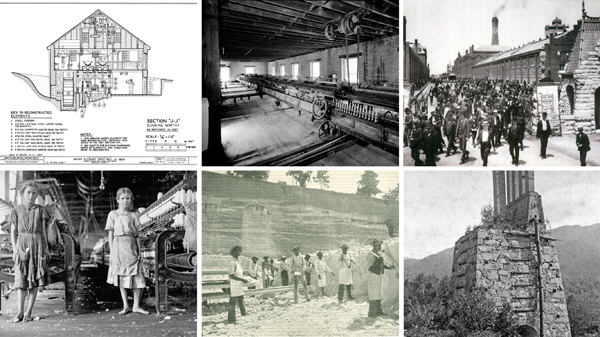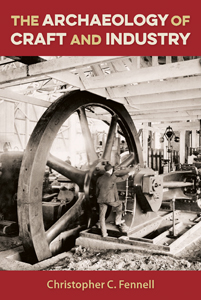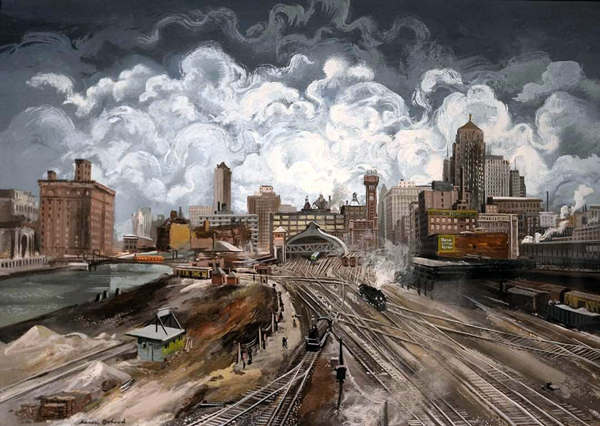|
Archaeologists investigating sites of craft and industrial enterprise often puzzle over a domain of bewildering ruins. Locations of remarkable energy, tumult, and creativity stand silent. This book provides an overview of the archaeology of American craft and industrial enterprises, outlines developments in theories, research questions, and interpretative frameworks, and presents case studies from a wide range of subjects (view this summary in pdf).
Research focused on industrial enterprises traverses a spectrum of perspectives. Some limit their efforts to recording, mapping, and studying the mechanics of a site. Others examine comparative questions of changes of technologies over time and space. Many analysts look away from the buildings and equipment of the workplace and focus instead on the workers, their families, residences, lifeways, and health experiences. With many sites presenting standing ruins, historians and archaeologists often encounter local stakeholder groups who wish to promote heritage themes and tourism potentials.
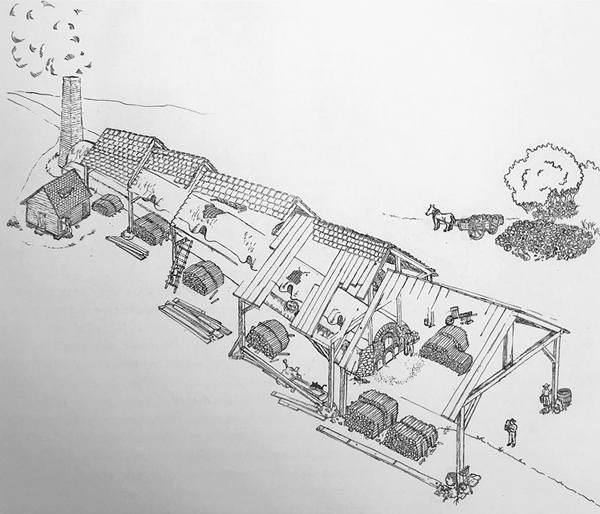
Conjectural reconstruction drawing of the Pottersville kiln in Edgefield, SC,
by Oliver Mueller-Heubach, courtesy of Robert Hunter and Oliver Mueller-Heubach.
All of these perspectives can be pursued with significant advances in research and curation methods. Investigations often range from microscopic analysis of product constituents to large-scale, three dimensional recording of locations and features with high-resolution, laser technologies. Past debates questioned whether primary emphasis should be on heritage recording or on archaeological research questions. More recent trends focus on collaborations across interest groups.
This expansive yet concise survey discusses archaeological research from sites across the United States that once manufactured, harvested, or processed commodities. Through studies of craft enterprise and the industrial revolution, this book uncovers key insights into American history from the seventeenth through the nineteenth centuries.
Exploring evidence from textile mills, glassworks, cutlery manufacturers, and tanneries, this book describes the complicated transition from skilled manual work to mechanized production methods, and I offer examples of how artisanal skill remained important in many factory contexts. The book also traces the distribution and transportation of goods along canals and railroads. This study delves into sites of extraction, such as lumber mills, copper mines, and coal fields, and reviews diverse methods for smelting and shaping iron. The book features an in-depth case study of my collaborative, multi-year project of investigations of Edgefield, South Carolina, a community that pioneered the production of alkaline-glazed stoneware pottery.
I outline shifts within the field of industrial archaeology over the past century that have culminated in the recognition that these locations of remarkable enterprise represent the lives and ingenuity of many people. In addition, I point to ways the field can help inform sustainable strategies for industrial enterprises in the present day.
Reviewers of this study observe —
“Fennell offers us a fresh and exciting expansion of industrial archaeology through the lens of craft production. This book, with its impressive array of case studies, unequivocally demonstrates the relevance of historical and industrial archaeology to the broader anthropological project.” — Charles E. Orser Jr., author of The Archaeology of Race and Racialization in Historic America.
“Sheds light on the vast array of craft and industrial work that shaped the American experience and the North American landscape. Fennell amasses a broad range of archaeological scholarship to identify contributions and new directions.” — Paul J. White, author of The Archaeology of American Mining.
“Fennell has penned a fascinating, enlightening work. . . . Without reservation, I recommend that all archaeologists and anthropologists read this book. As someone from Cleveland, Ohio, growing up in the heart of the rustbelt, I now have a new and enduring appreciation for the industrial archaeology around me, and for the countless people who lived their lives in and among historic craft and industry. As an experimental archaeologist, my mind is racing regarding what an experimental industrial archaeology might look like. For these enhanced perspectives, I am in Fennell's debt.” — Metin I. Eren, Department of Anthropology, Kent State University, Midcontinental Journal of Archaeology vol. 48, 2023 (link).
"This is a user-friendly volume you will want on your shelves for a quick—or not so quick—reference guide for a complex and diverse topic. . . . [H]is writing is clear, engaging, and well organized. He carefully summarizes and categorizes the range of research in historical archaeology and other fields on this industry. He ably and aptly gives credit to all of the scholars who have published on the topic in the last 20 years, particularly the graduate students working under his supervision between 2009 and 2016. He presents that multifaceted research as “ours,” not “mine.” This refreshing and collegial attitude makes Fennell an excellent author for a book that summarizes the work of so many. Thanks for setting a good example." — Martha A. Zierden, Charleston Museum, American Antiquity, 2024 (link).
“Fennell offers an updated review of how archaeologists have drawn meaning from the material culture of industries in the United States. As the title hints, the author's interest is in transformations between small-scale craft enterprises and sites of grander scale as found in archaeology and research. A brief glance at the book reveals that Fennell drew from a remarkable number of published sources, citing approximately 540 in just 167 pages.” — T. Arron Kotlensky, Pennsylvania Dept. of Transportation, Historical Archaeology, 2022.
This book’s expanded table of contents follows, along with a bibliography of sources and a list of internet resources related to industrial archaeology.
Table of Contents
1. Introduction: Craft, Industry, and Heritage
Manufacturing and Anthropogenic Impacts
Definitions, Methods, and Theories
Excavating Histories of Craft and Industrial Enterprises
2. Making and Harvesting Commodities: Episodes of Craft Growing to Industry
Rivers and Textiles
Winning and Losing in Cornell’s Pottery
Spinning Whimsies at Dyott’s Glassworks
Hand Tools, Trip Hammers, and Castaways at John Russell’s Cutlery
Making Do in Schroeders’ Saddle Tree Factory
Of Oysters, Abalone, and Salmon
Many Storied Domains of Bread, Biscuits, and Cheese
Artisan Support for an Armaments Factory
Bottles and Beer at Work and Home in Harpers Ferry
Binderies, Tanneries, and Social Perceptions
Races, Lime, and Fire at Shepherdstown Cement Mill
Some Observations and Affordances
3. Arteries and Flow
Rivers, Canals, and Shipping
Building the Rail Lines
Iron Trajectories and Wasteful Impacts
Pullman’s Rail Cars and Factory Town
Trends and Intersections
4. Extraction
Rails and Wood Cutting in West Virginia
Assemblies and Tools of Mining
From Cornwall to the Great Lakes
Colossal Montana
Hydraulic Assaults
Working the Cortez and Comstock Terrains in Nevada
Comparative Cases of Ethnicities, Cohesion, and Prejudices
Carving Coal in Berwind and Ludlow, Colorado
Mining and Murder at Lattimer, Pennsylvania
Ridge Barriers, Man Camps, and Magnetometers among the Oil Fields
Fueling Other Industries
5. Forges, Furnaces, and Metallurgy
Methods for the Melt
Early Smelting in New Mexico
Saugus Iron of Massachusetts
Trenton Steel Works of New Jersey
Strategies and Bloomeries in the Chesapeake
Landscape Challenges in Blacklog Narrows
Iron Plantations in South Carolina and Maryland
Women of Iron
Bluff Furnace of Tennessee
Tahawus Blast Innovations in New York
West Point Foundry on the Hudson
Jackson Iron Company of Michigan
Tredegar Iron and Cannons in Virginia
Hawks Nest Tunnel in West Virginia
Innovations, Pragmatic Choices, and Personal Costs
6. Craft at a Prodigious Scale: Potteries of Edgefield, South Carolina
Manufacturing Stoneware in Regional and Atlantic Contexts
Archaeological Revelations
Diverse Research Initiatives
7. Heritage Dynamics and Concluding Observations
Evolving Questions and Methods
Heritage Preserved and Repurposed
Future Prospects
About the author
I am an anthropologist specializing in historical archaeology as a Professor of Anthropology and Law at the University of Illinois at Urbana-Champaign, and a faculty affiliate of the Department of Landscape Architecture, College of Law, Center for African Studies, and the Department of African American Studies. I also serve as a yearly Visiting Professor of Law at the University of Chicago Law School, teaching seminars on the intersections of racism, law, social norms, and the social sciences.
My empirical research addresses subjects in trans-Atlantic historical archaeology and the dynamics of social group affiliations and lifeways among Europeans, Africans, and various social groups within the Americas. These research initiatives include interpretative frameworks focusing on social group identities, ethnic group dynamics and racialization, diaspora studies, regional systems and commodity chains, stylistic and symbolic elements of material culture, consumption patterns, and analysis of craft and industrial enterprises. I am also the founding editor of the Journal of African Diaspora Archaeology and Heritage, publisher and editor of the African Diaspora Archaeology Newsletter, member of the editorial board of the International Journal of Historical Archaeology, past member of the board of directors of the Coalition for Archaeological Synthesis, past member of the board of directors of the Society for Historical Archaeology, and past president of the Illinois Archaeological Survey. A list of my publications, including other books, research papers, other works in progress, and course offerings is provided in my resume.
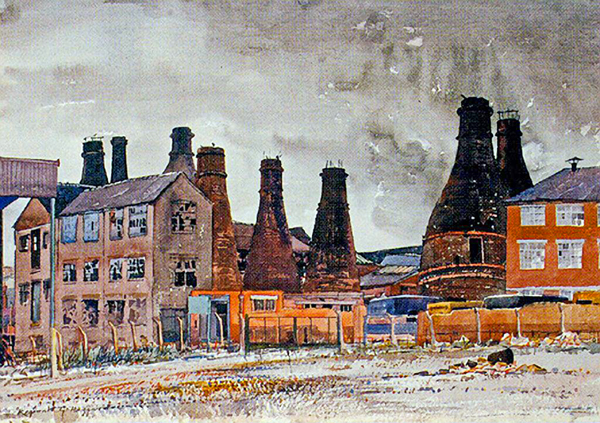
Reginald Haggar, The Gordon Pottery, Tunstall, 1969.
Bibliography on Archaeology of Craft and Industry
Abbott, C. M. 2004. Thomas Pollard: A Cornish Miner in the Appalachians. Mining History Journal 11: 25–34.
Adamson, G. 2022. Craft: An American History. New York: Bloomsbury.
Alfrey, J., and T. Putnam. 1992. The Industrial Heritage: Managing Resources and Uses. London: Routledge.
Albrecht, H. 2012. What Does the Industrial Revolution Signify? In Industrial Heritage Re-tooled: The TICCIH Guide to Industrial Heritage Conservation, edited by J. Douet, 17–23. Lancaster, United Kingdom: The International Committee for the Conservation of the Industrial Heritage.
Allitt, P. N. 2014. The Industrial Revolution. Chantilly, VA: Teaching Co.
Allom, T. 1831. Dolcoath Copper Mine in Camborne, Cornwall, Steel Engraving. In Cornwall Illustrated, in a Series of Views of Castles, Seats of the Nobility, Mines, Picturesque Scenery, Towns, Public Buildings, Churches, Antiquities, Original Drawings by T. Allot, engraved on steel by J. Thomas, Le Petit, et al., with Historical and Descriptive Accounts by J. Britton, and E. W. Brayley. London: Fisher and Co.
Anderson, R. K., Jr. 1996. Field Work and Measured Drawings. In Industrial Archaeology: Techniques, edited by E. L. Kemp, 133–166. Malabar, FL: Krieger Publishing Co.
Anonymous. 1876. Machine Hall Notes. Scientific American Supplement, June 10, 1(24): 370.
Arjona, J. M. 2017. Jug Factories and Fictions: A Mixed Methods Analysis of African-American Stoneware Traditions in Antebellum South Carolina. Journal of African Diaspora Archaeology and Heritage 6(3): 174–195.
Arjona, J., and T. Niculescu. 2014. Turning Clay into Craft: Field Notes from 2013 Excavations at Pottersville, SC. South Carolina Antiquities 46: 77–80.
Arnold, J. D. M., and D. Lafreniere. 2017. The Persistence of Time: Vernacular Preservation of the Postindustrial Landscape. Change Over Time 7(1): 114–133.
Ashton, T. S. 1948. The Industrial Revolution, 1760-1830. New York: Oxford University Press.
Atalay, S. 2012. Community-based Archaeology: Research with, by, and for Indigenous and Local Communities. Berkeley: University of California Press.
Australia Institution of Engineers. 1992. Engineering Heritage and Conservation Guidelines. Canberra, Australia: Paragon Printers.
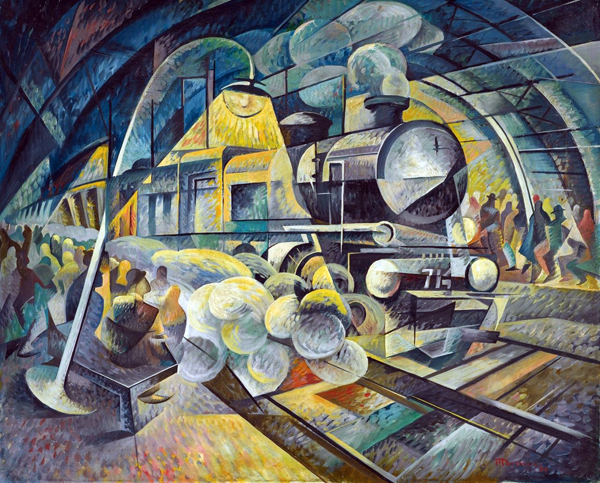
Antonio Marasco, Mechanical Power, 1934.
Baber, Chris, Tony Chemero, and Jamie Hall. 2017. What the Jeweller's Hand Tells the Jeweller's Brain: Tool Use, Creativity and Embodied Cognition. Philosophy and Technology 1129: 1-20.
Bailey, D. N., J. W. Lawrence, and P. W. Schopp. 2004. The Rise of the Industrial Rural Tenant Laborers and the Rise of the Industrial Economy: Historical Ethnography of the Heminitz Property, Site 36LH267, Upper Macungie Township, Lehigh County, Pennsylvania. Northeast Historical Archaeology 33(1): 91–110.
Baird, M. F. 2017. Critical Theory and the Anthropology of Heritage Landscapes. Gainesville: University Press of Florida.
Baldwin, C. K. 1993. Great and Noble Jar: Traditional Stoneware of South Carolina. Athens: University of Georgia Press.
Balée, W. L. 1998. Historical Ecology: Premises and Postulates. In Advances in Historical Ecology, edited by W. Balée, 13–29. New York: Columbia University Press.
Balée, W. L. 2006. The Research Program in Historical Ecology. Annual Review of Anthropology 35(1): 75–98.
Barka, N. F. 2004. Archaeology of a Colonial Pottery Factory: The Kilns and Ceramics of the “Poor Potter” of Yorktown. Ceramics in America 2004: 15–47.
Barnes, L. D. 2011. Industry and its Laborers, Free and Slave in Late-antebellum Virginia. In The Old South’s Modern Worlds: Slavery, Region, and Nation in the Age of Progress, edited by L. D. Barnes, B. Schoen, and F. Towers, 189–206. New York: Oxford University Press.
Bartos, P. J. 2009. A Light in the Darkness: U.S. Mine Lamps, the Early Years—Candlesticks, Oil Lamps, and Safety Lamps. Mining History Journal 16: 45–63.
Bates, B. T. 2001. Pullman Porters and the Rise of Protest Politics in Black America, 1925-1945. Chapel Hill: University of North Carolina Press.
Bauer, A. M. 2015. Questioning the Anthropocene and Its Silences: Socioenvironmental History and the Climate Crisis. Journal of the Environmental Humanities 3: 403–426.
Bauer, A. M., and E. C. Ellis 2018. The Anthropocence Divide: Obscuring Understanding of Socio-environmental Change. Current Anthropology 59(2): 209–227.
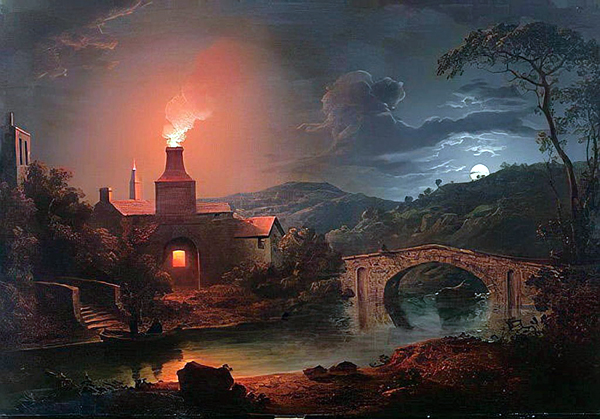
Sebastian Pether, Ironworks by Moonlight.
Baxter, J. E. 2012. The Paradox of a Capitalist Utopia: Visionary Ideals and Lived Experience in the Pullman Community, 1880-1900. International Journal of Historical Archaeology 16(4): 651–665.
Baxter, J. E. 2019. The Archaeology of American Childhood and Adolescence. Gainesville: University Press of Florida.
Baxter, R. S. 2002. Industrial and Domestic Landscapes of a California Oil Field. Historical Archaeology 36(3): 18–27.
Baxter, R. S., and R. Allen. 2015. The View from Summit Camp. Historical Archaeology 49(1): 34–45.
Bayman, J. M. 1999. Craft Economies in the North American Southwest. Journal of Archaeological Research 7(3): 249–299.
Beaudry, M. C. 2006. Findings: The Material Culture of Needlework and Sewing. New Haven, CT: Yale University Press.
Beesley, D. 2000. Beyond Gilbert: Environmental History and Hydraulic Mining in the Sierra Nevada. Mining History Journal 7: 71–80.
Belford, P. 2014. Contemporary and Recent Archaeology in Practice. Industrial Archaeology Review 36(1): 3–14.
Belford, P. 2018. Blood, Faith and Iron: A Dynasty of Catholic Industrialists in Sixteenth- and Seventeenth-century England. Oxford, UK: Archaeopress.
Bell, E. L. 1983. The O’Neal-Forshee Iron Mining Settlement. Bulletin and Journal for Archaeology of New York State 86 (Spring): 2-30.
Bell, I. L. 1876. On the Hot Blast, with an Explanation of its Mode of Action in Iron Furnaces of Different Capacities. Transactions of the American Institute of Mining Engineers 5: 56–81.
Benjamin, J. 2014. The Industrial Sonifact and the Soundscape of the Anthropocene. Journal of Contemporary Archaeology 1(1): 119–123.
Bentz, L., and T. J. Braje. 2017. Sea of Prosperity: Foundations of the California Commercial Abalone Fishery. International Journal of Historical Archaeology 21(3): 598–622.
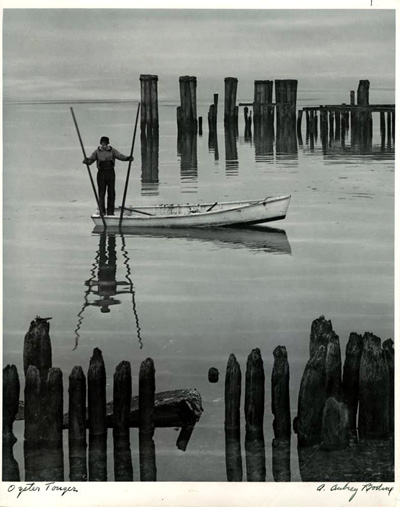
A. Aubrey Bodine, Oyster Tonger, Tilghman Island, Maryland, 1948.
Berger, S. (ed.). 2020. Constructing Industrial Pasts: Heritage, Historical Culture and Identity in Regions Undergoing Structural Economic Transformation. New York: Berghahn.
Bezís-Selfa, J. 2004. Forging America: Ironworkers, Adventurers and the Industrial Revolution. Ithaca, NY: Cornell University Press.
Bining, A. C. 1938. Pennsylvania Iron Manufacture in the Eighteenth Century. Harrisburg: Pennsylvania Historical and Museum Commission.
Botwick, B., and D. A. McClane. 2005. Landscapes of Resistance: A View of the Nineteenth-century Chesapeake Bay Oyster Fishery. Historical Archaeology 39(3): 94–112.
Bourdieu, P. 1977. Outline of a Theory of Practice. Cambridge, UK: Cambridge University Press.
Bracegirdle, B. (ed.) 1973. The Archaeology of the Industrial Revolution. London: Heinemann.
Bradford, K. 2004. Introduction of the Original Anagama in Fifth Century; Comparison between Ogama and Anagama. Ceramics Monthly 52(6): 126–128.
Braje, T. D. 2015. Earth Systems, Human Agency, and the Anthropocene: Planet Earth in the Human Age. Journal of Archaeological Research 23: 369–396.
Braje, T. J., J. M. Erlandson, and C. R. Torben. 2007. An Historic Chinese Abalone Fishery on California’s Northern Channel Islands. Historical Archaeology 41(4): 117–128.
Brashler, J. G. 1991. When Daddy was a Shanty Boy: The Role of Gender in the Organization of the Logging West Virginia. Historical Archaeology 25(4): 54–68.
Breen, T. H. 2004. The Marketplace of Revolution: How Consumer Politics Shaped American Independence. New York: Oxford University Press.
Briggs, A. 1979. Iron Bridge to Crystal Palace: Impact and Images of the Industrial Revolution. London: Thames and Hudson.
Brown, J. L. 1977. Exploratory Archaeological Excavations at the Bluff Furnace site. Miscellaneous Paper I. Institute of Archaeology, University of Tennessee, Chattanooga.
Brown, R. C. 2016. Power Line: Memory and the March on Blair Mountain. In Excavating Memory: Sites of Remembering and Forgetting, edited by M. T. Starzmann and J. R. Roby, 86–107. Gainesville: University Press of Florida.
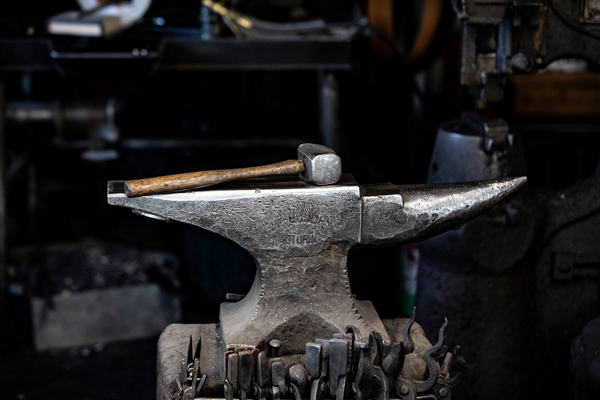
Elemental.
Bruce, K. 1931. Virginia Iron Manufacture in the Slave Era. New York: Century Co.
Bruner, E. M. 1993. Epilogue: Creative Persona and the Problem of Authenticity. In Creativity/Anthropology, edited by S. Lavie, K. Narayan, and R. Rosaldo, 321–334. Ithaca, NY: Cornell University Press.
Bruwelheide, K. S., D. W. Owsley, K. G. Barca, C. A. M. France, N. C. Little, and E. A. Comer. 2020. Restoring Identity to People and Place: Reanalysis of Human Skeletal Remains from a Cemetery at Catoctin Furnace, Maryland. Historical Archaeology 54(1): 110–137.
Buchanan, R. A. 2000. The Origins of Industrial Archaeology. In Perspectives on Industrial Archaeology, edited by N. Cossons, 18–38. London: Science Museum.
Buder, S. 1967. Pullman: An Experiment in Industrial Order and Community Planning, 1880-1930. New York: Oxford University Press.
Burke, C., and S. M. Spencer-Wood. 2018. Introduction. In Crafting in the World: Materiality in the Making, edited by C. Burke and S. M. Spencer-Wood, 1-16. New York: Springer Press.
Burmeister, S., and R. Bernbeck (eds). 2017. The Interplay of People and Technologies. Archaeological Case Studies on Innovations. Berlin Studies of the Ancient World 43. Berlin: Edition Topoi.
Burns, J. A. (ed.) 2004. Recording Historic Structures. Hoboken, NJ: John Wiley and Sons.
Burrison, J. 1983. Brothers in Clay: The Story of Georgia Folk Pottery. Athens: University of Georgia Press.
Burrison, J. 2010. From Mud to Jug: The Folk Potters and Pottery of Northeast Georgia. Athens: University of Georgia Press.
Burt, R. 2007. Technological Backwardness in the Western American Mining Industry in the Nineteenth Century. Mining History Journal 14: 23–39.
Burton, O. V. 1985. In My Father’s House are Many Mansions: Family and Community in Edgefield, South Carolina. Chapel Hill: University of North Carolina Press.
Burton, O. V. 1998. Edgefield, South Carolina, Home of Dave the Potter. In “I Made This Jar . . .” The Life and Works of the Enslaved African-American Potter, Dave, edited by J. B. Koverman, 39–52. Columbia: McKissick Museum, University of South Carolina.
Burton, O. V. 2007. The Age of Lincoln. New York: Hill and Wang.
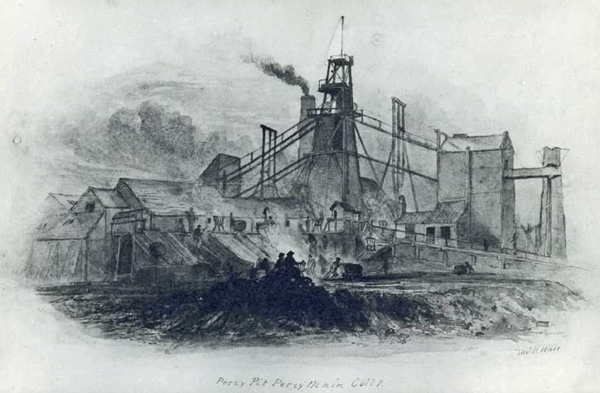
Thomas Hair, Percy Pit, Percy Main Colliery, mid-1800s.
Caldwell, J. E. 1951. A Tour through Part of Virginia in the Summer of 1808. Richmond, VA: Dietz Press; facsimile reprint of 1809 edition published by the author in New York.
Calfas, G. W. 2011. Asian Inspired Kilns in South Carolina? South Carolina Antiquities 43: 76–77.
Calfas, G. W. 2013. Nineteenth Century Stoneware Manufacturing at Pottersville, South Carolina: The Discovery of a Dragon Kiln and the Reinterpretation of a Southern Pottery Tradition. Ph.D. Dissertation, Department of Anthropology, University of Illinois, Urbana-Champaign.
Calfas G. W. 2017. A Dragon Kiln in the Americas: European-American Innovation and African-American Industry. Journal of African Diaspora Archaeology and Heritage 6(2): 80–99.
Calfas, G. W. 2018. Shifted Perspectives on Dave: Implications of Archaeological Excavation at the Pottersville Kiln Site. In Where is All My Relation? The Poetics of Dave the Potter, edited by M. A. Chaney, 58–79. New York: Oxford University Press.
Calfas, G. W., C. C. Fennell, B. Kenline, and C. Steen. 2011. Archaeological Investigations, LiDAR Aerial Survey, and Compositional Analysis of Pottery in Edgefield, South Carolina. South Carolina Antiquities 43: 33–40.
Caplinger, M. W. 1997. Bridges over Time: A Technological Context for the Baltimore and Ohio Railroad Main Stem at Harpers Ferry, West Virginia. Morgantown: West Virginia University Institute for the History of Technology and Industrial Archaeology.
Caraher, W. R., and B. A. Weber. 2017. The Bakken: An Archaeology of an Industrial Landscape. Fargo: North Dakota State University Press.
Caraher, W. R., B. Weber, K. Kourelis, and R. Rothaus. 2017. The North Dakota Man Camp Project: The Archaeology of Home in the Bakken Oil Fields. Historical Archaeology 51(2): 267–287.
Caraher, W. R., B. Weber, and R. Rothaus. 2018. Lessons from the Bakken Oil Patch. In The New Nomadic Age: Archaeologies of Forced and Undocumented Migration, edited by Y. Hamilakis, 87–96. Sheffield, UK: Equinox Publishing, Ltd.
Carlson, T. L. 1951. The Illinois Military Tract: A Study of Land Occupation, Utilization, and Tenure. Urbana: University of Illinois Press.
Casella, E. C. 2005. “Social Workers:” New Directions in Industrial Archaeology. In Industrial Archaeology: Future Directions, edited by E. C. Casella and J. Symonds, 3–31. New York: Springer.
Casella, E. C., and J. Symonds (eds.) 2005. Industrial Archaeology: Future Directions. New York: Springer.
Casella, E. C., M. Nevell, and H. Steyne (eds.) 2022. Oxford Handbook of Industrial Archaeology. London: Oxford University Press.
Cassell, M. S., and M. O. Stachiw. 2005. Perspectives on Landscapes of Industrial Labor. Historical Archaeology 39(3): 1–7.
Castille, G., C. Baldwin, and C. Steen. 1988. Archaeological Survey of Alkaline Glazed Stoneware Production Sites in the Old Edgefield District, South Carolina. McKissick Museum, and the South Carolina Institute of Archaeology and Anthropology. Columbia: University of South Carolina.
Cha-Jua, S. K. 2000. America’s First Black Town, Brooklyn, Illinois, 1830-1915. Urbana: University of Illinois Press.
Chace, P. G., and W. S. Evans, Jr. 2015. Celestial Sojourners in the High Sierras: The Ethno-archaeology of Chinese Railroad Workers (1865-1868). Historical Archaeology 49(1): 27–33.
Chambers F. M. 2003. Setting the Scene. In The Environmental Archaeology of Industry, edited by P. Murphy and P. E. Wiltshire, 4–8. Symposia of the Association for Environmental Archaeology, No. 20. Oxford, UK: Oxbow.
Chaney, M. A. 2008. Fugitive Vision: Slave Image and Black Identity in Antebellum Narrative. Bloomington: Indiana University Press.
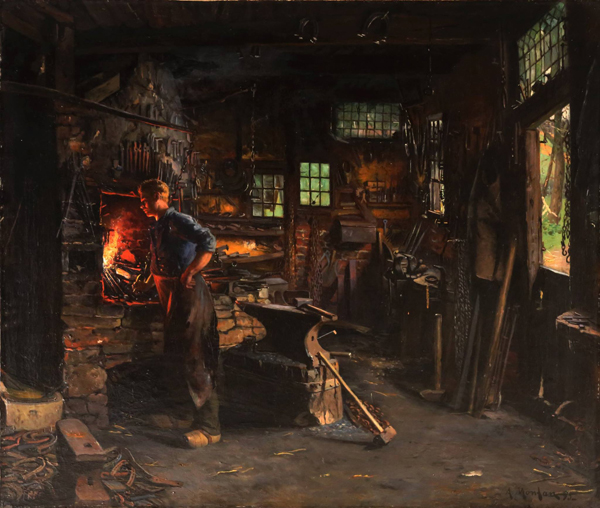
Anders Montan, Blacksmith’s Shop.
Chang, G. H. 2019. Ghosts of Gold Mountain: The Epic Story of the Chinese Who Built the Transcontinental Railroad. Boston, MA: Houghton Mifflin Harcourt.
Chapman, C. C. 1880. History of Pike County, Illinois. Chicago: Charles C. Chapman and Co.
Chen, L. 1986. The Qionglai Kilns. In Scientific and Technological Insights on Ancient Chinese Pottery and Porcelain, edited by S. Zhao, 321–324. Peking: Shanghai Institute of Ceramics and Science Press.
Cherniack, M. 1986. The Hawks Nest Incident: America’s Worst Industrial Disaster. New Haven, CT: Yale University Press.
Cleeman, T. M. 1880. The Railroad Engineer’s Practice. New York: G. H. Frost.
Cleere, H. 2000. The World Heritage Convention as a Medium for Promoting the Industrial Heritage. IA: Journal of the Society for Industrial Archaeology 26(2): 31–42.
Coffee, K. 2021. Industrial Lowell and the Dawn of the Anthropocene. Industrial Archaeology Review 43(1): 20-33.
Comstock, H. E. 1994. The Pottery of the Shenandoah Valley Region. Chapel Hill: Museum of Early Southern Decorative Arts and University of North Carolina Press.
Conger, J. L. 1932. History of the Illinois River Valley. Chicago: S. J. Clarke.
Cooper, C. C. 1988. “A Whole Battalion of Stackers”: Thomas Blanchard’s Production Line and Hand Labor at Springfield Armory. IA: Journal of the Society for Industrial Archaeology 14(1): 36–58.
Cootner, P. H. 1963. The Role of the Railroads in United States Economic Growth. Journal of Economic History 23(4): 477–521.
Cossin, Z. A. 2017. The Social Landscape of Potteries: Refined Earthenwares at Pottersville, South Carolina. Journal of African Diaspora Archaeology and Heritage 6(3): 225–242.
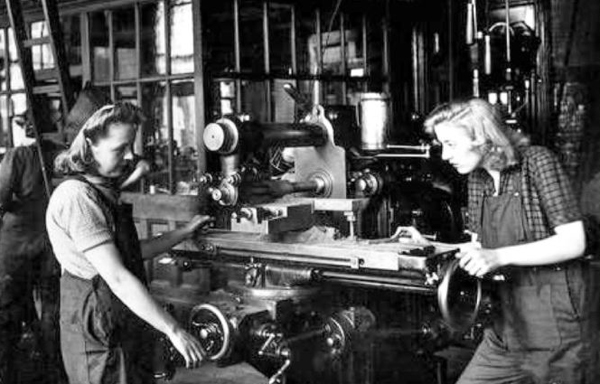
Trainee munition workers operating a milling machine,
Belfast Municipal College of Technology, 1942.
Cossons, N. 2000. Perspective. In Perspectives on Industrial Archaeology, edited by N. Cossons, 9–17. London: Science Museum.
Costin, C. L. 1991. Craft Specialization: Issues in Defining, Documenting, and Explaining the Organization of Production. In Archaeological Method and Theory, volume 3, edited by M. B. Schiffer, pp. 1-55. Tucson: University of Arizona Press.
Costin, C. L. 1998. Introduction: Craft and Social Identity. In Craft and Social Identity, edited by C. L. Costin and R. Wright, pp. 3-16. Archaeological Paper of the American Anthropological Association. New York: American Anthropological Association.
Cotter, J. L. 1968. Review of “Industrial Archaeology: An Introduction,” by K. Hudson. American Anthropologist 70: 422.
Cotter, J. L., and P. J. Hudson. 1957. New Discoveries at Jamestown, Site of the First Successful English Settlement in America. Washington, DC: National Park Service.
Council, R. B., N. Honerkamp, and M. E. Will. 1992. Industry and Technology in Antebellum Tennessee: The Archaeology of Bluff Furnace. Knoxville: University of Tennessee Press.
Cowen, R. S. 1976. The “Industrial Revolution” in the Home: Household Technology and Social Change in the Twentieth Century. Technology and Culture 17(1): 1–23.
Cowie, J., and J. Heathcott. 2003. Beyond the Ruins: The Meanings of Deindustrialization. Ithaca, NY: Cornell University Press.
Cowie, S. E. 2011. The Plurality of Power: An Archaeology of Industrial Capitalism. New York: Springer.
Cowie, S. E. 2015. Bridging Social Anthropology and Industrial Archaeology at a Georgia Grist Mill. North American Archaeologist 36(1): 33–57.
Crane, S. 1894. In the Depths of a Coal Mine. McClure’s Magazine 3(3): 195–209.
Cranstone, D. 2004. The Archaeology of Industrialization—New Directions. In The Archaeology of Industrialization, edited by D. Barker and D. Cranstone, 313–320. Leeds, UK: Maney Publishing.
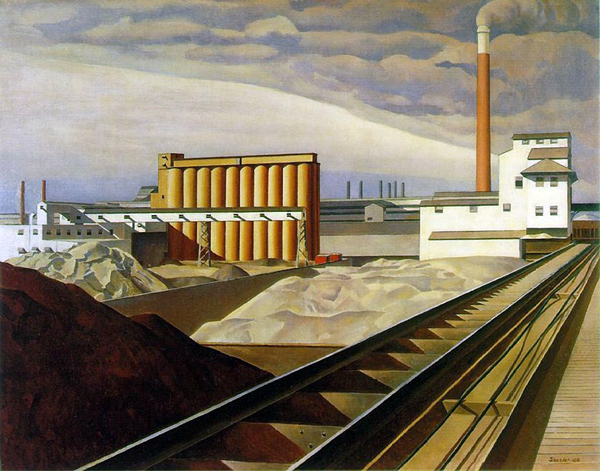
Charles Sheeler, Classic Landscape, 1931.
Crawford, M. 1986. Building the Workingman’s Paradise: The Design of American Company Towns. New York: Verso.
Creel, M. W. 1988. “A Peculiar People”: Slave Religion and Community-Culture Among the Gullahs. New York: New York University Press.
Crossland, Z. 2014. The Anthropocene: Locating Agency, Imagining the Future. Journal of Contemporary Archaeology 1(1): 123–128.
Crutzen, P. J. 2002. Geology of Mankind. Nature 415(6867): 23.
Crutzen, P. J., and E. F. Stoermer. 2000. The “Anthropocene.” Journal de Physique IV 12: 1–5.
Cuddy, T. W. 2008. Revolutionary Economies: What Archaeology Reveals about the Birth of American Capitalism. Lanham, MD: AltaMira Press.
Davis, J. 1922. The Iron Puddler: My Life in the Rolling Mills and What Came of It. Indianapolis, IN: Bobbs-Merrill Co.
Davis, J. E. 1998. Frontier Illinois. Bloomington: Indiana University Press.
Deane, P. 1979. The First Industrial Revolution. Cambridge, UK: Cambridge University Press.
Dearinger, R. 2016. The Filth of Progress: Immigrants, Americans, and the Building of Canals and Railroads in the West. Oakland: University of California Press.
de Groft, A. 1998. Eloquent Vessels/Politics of Power: The Heroic Stoneware of “Dave the Potter.” Winterthur Portfolio 33(4): 249–260.
Delgado, J. P. 2019. War at Sea: A Shipwrecked History from Antiquity to the Twentieth Century. Oxford, UK: Oxford University Press.
Delle, J. A., S. A. Mrozowski, and R. Paynter (eds.) 2000. Lines That Divide: Historical Archaeologies of Race, Class, and Gender. Knoxville: University of Tennessee Press.
Dent, R. J. 1986. On the Archaeology of Early Canals: Research on the Patowmack Canal in Great Falls, Virginia. Historical Archaeology 20(1): 50–62.
de Souza, M. A. T., and D. M. Costa. 2018. Introduction: Historical Archaeology and the Environment. In Historical Archaeology and the Environment, edited by M. A. T. de Souza and D. M. Costa, 1–15. New York: Springer.
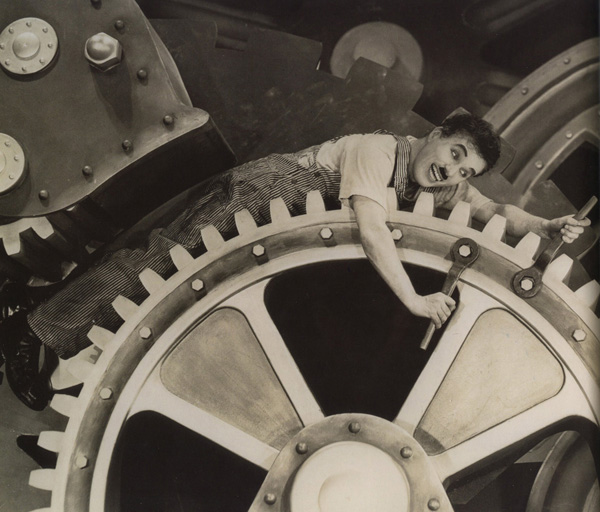
Charlie Chaplin in Modern Times film, 1936.
DeVore, S. L. 1990. Fur Trade Era Blacksmith Shops at Fort Union Trading Post National Historic Site, North Dakota. Historical Archaeology 24(3): 1–23.
Dew, C. B. 1966. Iromaker to the Confederacy: Joseph R. Anderson and the Tredegar Iron Works. New Haven, CT: Yale University Press.
Dew, C. B. 1974. David Ross and the Oxford Iron Works: A Study of Industrial Slavery in the Early Nineteenth-century South. William and Mary Quarterly 31(2): 189–224.
Dew, C. B. 1994. Bond of Iron: Master and Slave at Buffalo Forge. New York: W. W. Norton and Co.
Dickens, C. 1842. American Notes. Vol. 1. London: Chapman and Hall.
Diderot, D., and J. D’Alembert. 1763. Encyclope´die, ou Dictionnaire Raisonne´ des Sciences, des Arts et des Me´tiers, par une Socie´te´ de Gens de Lettres. Paris: Chez Briasson and others.
Ding, Y., and R. Hsu. 2019. Overseas Remittances of Chinese Laborers in North America. In The Chinese and the Iron Road: Building the Transcontinental Railroad, edited by G. H. Chang and S. F. Fishkin, 77–89. Stanford, CA: Stanford University Press.
Dixon, K. J. 2014. Historical Archaeologies of the American West. Journal of Archaeological Research 22(3): 177–228.
Dixon, K. J., and S. Smith. 2017. Rock Hearths and Rural Wood Camps in Jin Shan/Gam Saan: National Register of Historic Places Evaluations of the 19th-century Chinese Logging Operations at Heavenly Ski Resort in the Lake Tahoe Basin. In Historical Archaeology through a Western Lens, edited by M. S. Warner and M. S. Purser, 113–137. Lincoln: University of Nebraska Press and the Society for Historical Archaeology.
Dixon, K. J., G. Weisz, C. Merritt, R. Weaver, and J. Bard. 2019. Landscapes of Change: Culture, Nature, and the Archaeological Heritage of Transcontinental Railroads in the North American West. In The Chinese and the Iron Road: Building the Transcontinental Railroad, edited by G. H. Chang and S. F. Fishkin, 126–158. Stanford, CA: Stanford University Press.
Donovan, J. 2012. Feminist Theory: The Intellectual Traditions. London: Continuum.
Douet, J. 2012a. Introduction. In Industrial Heritage Re-tooled: The TICCIH Guide to Industrial Heritage Conservation, edited by J. Douet, 1–4. Lancaster, UK: The International Committee for the Conservation of the Industrial Heritage.
Douet, J. (ed.) 2012b. Industrial Heritage Re-tooled: The TICCIH Guide to Industrial Heritage Conservation. Lancaster, UK: The International Committee for the Conservation of the Industrial Heritage.
Douet, J. 2020. The Heritage of the Oil Industry: TICCIH Thematic Study. Lancaster, UK: The International Committee for the Conservation of the Industrial Heritage.
Downey, T. 2006. Planting a Capitalist South: Masters, Merchants, and Manufacturers in the Southern Interior, 1790-1860. Baton Rouge: Louisiana State University Press.
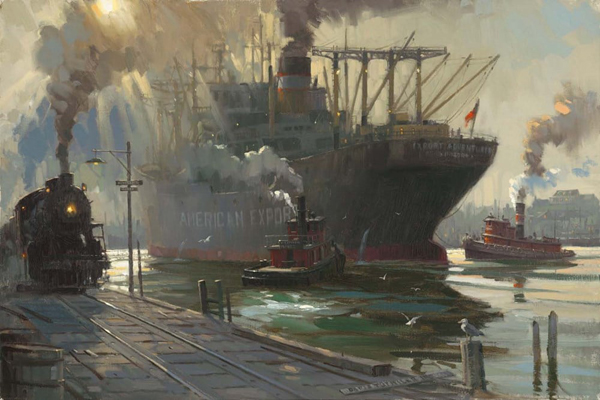
David Tutwiler, Steam on the Waterfront.
Du Bois, W. E. B. 1902. The Negro Artisan. Atlanta, GA: Atlanta University Press.
Du Halde, J. B. 1736. The General History of China. London: J. Watts.
Dyott, T. W. 1833. An Exposition of the System of Moral and Mental Labor, Established at the Glass Factory of Dyottville. Philadelphia, PA: T. W. Dyott.
Eddisford, D., and C. Morgan. 2018. Single Context Archaeology as Anarchist Praxis. Journal of Contemporary Archaeology 5(2): 149–157.
Edensor, T. 2005. Industrial Ruins: Spaces, Aesthetics and Materiality. Oxford, UK: Berg.
Edwards, A., J. Harwood, J. Richter, and T. Goyens. 2013. James Wray’s Carpentry Yard: Archaeology of an Early Williamsburg Industrial Craft Site. Post-Medieval Archaeology 47(1): 35–65.
Egleston, T. 1880. The American Bloomary Process for Making Iron Direct from the Ore. Transactions of the American Institute of Mining Engineers 8: 515–530.
Ellsworth, L. F. 1972. Craft to National Industry in the Nineteenth Century: A Case Study of the Transformation of the New York State Tanning Industry. Journal of Economic History 32(1): 399–402.
Ellsworth, L. F. 1975. Craft to National Industry in the Nineteenth Century: A Case Study of the Transformation of the New York State Tanning Industry. New York: Arno Press.
Eltis, D., and M. Halbert (eds.) 2009. Voyages: Trans-Atlantic Slave Trade Database. http://www.slavevoyages.org/.
Emmons, D. M. 1989. The Butte Irish: Class and Ethnicity in an American Mining Town, 1875-1925. Urbana: University of Illinois Press.
Engels, F. 1958. The Condition of the Working Class in England. Stanford, CA: Stanford University Press. Translated by W. O. Henderson and W. H. Chaloner.
Ensign, D. W. 1872. Atlas Map of Pike County, Illinois. Davenport, IA: Andreas, Lyter and Co.
Epperson, T. 1999. Constructing Difference: The Social and Spatial Order of the Chesapeake Plantation. In “I, Too, Am America:” Archaeological Studies of African-American Life, edited by T. A. Singleton, 159–172. Charlottesville: University Press of Virginia.
Espenshade, C. T. 2002. Taming the Groundhog: Excavations at the Sligh Stoneware Pottery, Paulding County, Georgia. Early Georgia 30(2): 183–193.
Falconer, K. 2010. Industrial World Heritage Sites: Shifting Perceptions from Icons to Cultural Landscape. In Footprints of Industry: Papers from the 300th Anniversary Conference at Coalbrookdale, edited by P. Belford, M. Palmer, and R. White, 233–240. Oxford, UK: Archaeopress.
Faulkner, A. 1985. Archaeology of the Cod Fishery: Damariscove. Historical Archaeology 19(2): 57–86.
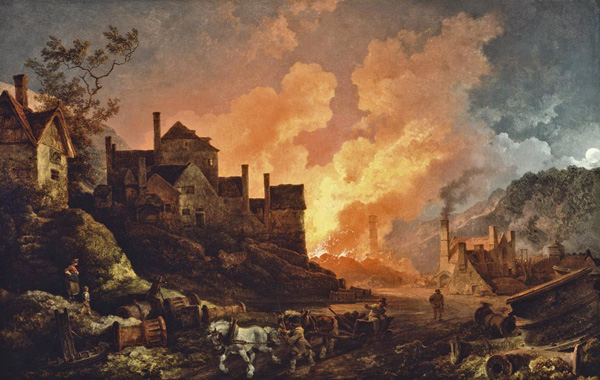
Philip James de Loutherbourg, Coalbrookedale by Night, 1801.
Felkin, W. 1867. A History of the Machine Wrought Hosiery and Lace Manufacturers. London: Longmans, Green and Co.
Fennell, C. C. 2007. Crossroads and Cosmologies: Diasporas and Ethnogenesis in the New World. Gainesville: University Press of Florida.
Fennell, C. C. 2010. Damaging Detours: Routes, Racism and New Philadelphia. Historical Archaeology 44(1): 138–154.
Fennell, C. C. 2011. Literate Inversions and Cultural Metaphors in Edgefield Stoneware. Historical Archaeology 45(2): 156–162.
Fennell, C. C. 2014. Artifacts to Invoke, Direct, and Deflect. In “Manifestations of Magic: The Archaeology and Material Culture of Folk Religion,” special issue edited by C. C. Fennell and M. C. Manning. Historical Archaeology 48(3): 196–200.
Fennell, C. C. 2017a. Broken Chains and Subverted Plans: Ethnicity, Race, and Commodities. Gianesville: University Press of Florida.
Fennell, C. C. 2017b. Innovation, Industry, and African-American Heritage in Edgefield, South Carolina. Journal of African Diaspora Archaeology and Heritage 6(2): 1–23.
Ferguson, L. 1992. Uncommon Ground: Archaeology and Early African America, 1600–1800. Washington, DC: Smithsonian Institution Press.
Ferguson, T. A., and T. A. Cowan. 1997. Iron Plantations and the Eighteenth- and Nineteenth-Century Landscape of the Northwestern South Carolina Piedmont. In Carolina’s Historical Landscapes: Archaeological Perspectives, edited by L. F. Stine, M. Zierden, L. M. Drucker, and C. Judge, 113–144. Knoxville: University of Tennessee Press.
Ferreira, R. 2008. The Suppression of the Slave Trade and Slave Departures from Angola, 1830s-1860s. In Extending the Frontiers: Essays on the New Transatlantic Slave Trade Database, edited by D. Eltis and D. Richardson, 313–334. New Haven, CT: Yale University Press.
Fike, R. E. 1987. The Bottle Book: A Comprehensive Guide to Historic, Embossed Medicine Bottles. Salt Lake City, UT: Gibbs M. Smith.
Fishlow, A. 1971. American Railroads and the Transformation of the Ante-bellum Economy. Cambridge, MA: Harvard University Press.
Foner, P. S., and R. L. Lewis (eds.). 1989. Black Workers: A Documentary History from Colonial Times to the Present. Philadelphia, PA: Temple University Press.
Foster, J. W., and J. D. Whitney. 1850. Report on the Geology and Topography of a Portion of the Lake Superior Land District in the State of Michigan, 2 vols. Washington, DC: Printed for the U.S. House of Representatives.
Fox, M. C. 2019. Geography, Geology, and Genius: How Coal and Canals Ignited the American Industrial Revolution. Easton, PA: Canal History and Technology Press, Delaware and Lehigh National Heritage Corridor.
Fracchia, A., and M. Roller. 2015. Labor Archeology of the Industrial Era: Identifying and Evaluating Nationally Significant Archeological Sites of Labor in the Industrial Era in the United States. Washington, DC: National Park Service.
Francaviglia, R. V. 1991. Hard Places: Reading the Landscape of America’s Historic Mining Districts. Iowa City: University of Iowa Press.
Francaviglia, R. V. 1998. In Her Image: Some Reflections on Gender and Power in Mining History. Mining History Journal 5: 118–126.
Francaviglia, R. V. 2001. Maps and Mining: Some Historical Examples from the Great Basin. Mining History Journal 8: 66–82.
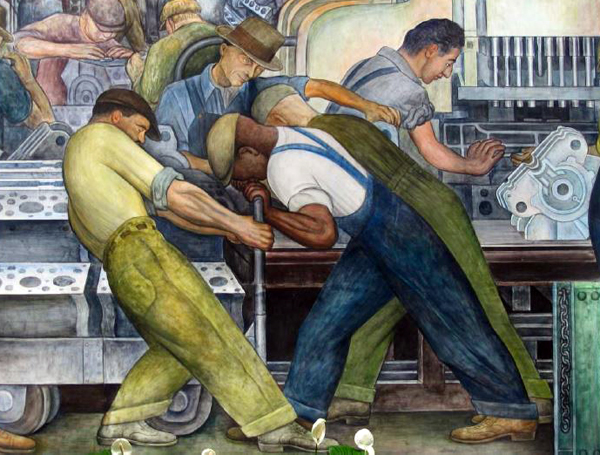
Diego Rivera, Workers, mural detail.
Franzen, J. G. 1992. Northern Michigan Logging Camps: Material Culture and Worker Adaptation on the Industrial Frontier. Historical Archaeology 26(2): 74–98.
Franzen, J. G. 2020. The Archaeology of the Logging Industry. Gainesville: University Press of Florida.
Freeman, J. B. 2018. Behemoth: A History of the Factory and the Making of the Modern World. New York: W. W. Norton and Co.
Frehner, B. 1996. Ethnicity and Class: The Italian Charcoal Burners’ Wars, 1875-1885. Nevada Historical Society Quarterly 39(1): 43–62.
Furnis, L., and M. L. Maniery. 2015. An Archaeological Strategy for Chinese Workers’ Camps in the West: Method and Case Study. Historical Archaeology 49(1): 71–84.
Gaertner, S. L., and J. F. Dovidio. 1986. The Aversive Form of Racism. In Prejudice, Discrimination, and Racism, edited by J. F. Dovidio and S. L. Gaertner, 61–89. Orlando, FL: Academic Press.
Gale, W. K. 1973. Iron and Steel. In The Archaeology of the Industrial Revolution, edited by B. Bracegirdle, 148–166. London: Heinemann.
Gardner, J. S. 2012. A Mine is a Terrible Thing to Waste: Kentucky’s Portal 31 Exhibition Mine. Mining History Journal 19: 58–68.
Garner, J. S. (ed.) 1992. The Company Town: Architecture and Society in the Early Industrial Age. New York: Oxford University Press.
Garrison, E. G. 1995. Three Ironclad Warships—The Archaeology of Industrial Process and Historical Myth. Historical Archaeology 29(4): 26–38.
Gibb, J. G., D. J. Bernstein, and D. F. Cassedy. 1990. Making Cheese: Archaeology of a 19th Century Rural Industry. Historical Archaeology 24(1): 18–33.
Gibb, J. G., D. J. Bernstein, and S. Zipp. 2009. Farm and Factory: Agricultural Production Strategies and the Cheese and Butter Industry. Historical Archaeology 43(2): 83–107.
Giddens, A. 1979. Central Problems in Social Theory: Action, Structure and Contradiction in Social Analysis. Berkeley: University of California Press.
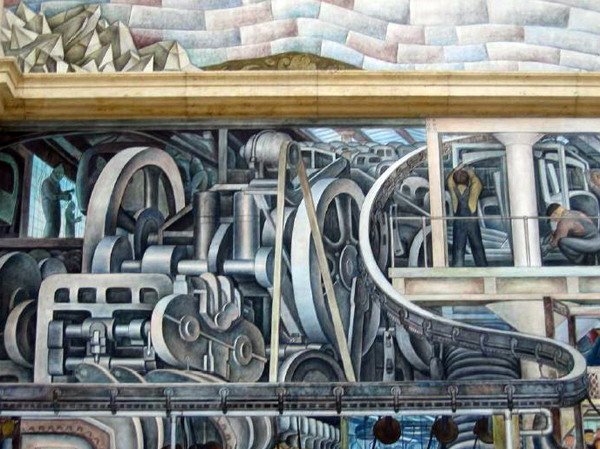
Diego Rivera, Jungle of Steel, mural detail.
Gilbert, D. T. 1999. Waterpower: Mills, Factories, Machines and Floods at Harpers Ferry, West Virginia, 1762-1991. Harpers Ferry, WV: Harpers Ferry Historical Association.
Gillespie, W. B., and M. M. Farrell. 2002. Work Camp Settlement Patterns: Landscape-scale Comparisons of Two Mining Camps in Southeastern Arizona. Historical Archaeology 36(3): 59–68.
Goldberg, A. F., and D. A. Goldberg. 2017. The Expanding Legacy of the Enslaved Potter-poet David Drake. Journal of African Diaspora Archaeology and Heritage 6(3): 243–261.
Goldberg, A., and J. P. Witkowski. 2006. Beneath His Magic Touch: The Dated Vessels of the African-American Slave Potter Dave. Ceramics in America 2006: 58–92.
Goodrich, C. L., and F. A. Stanley. 1907. Accurate Tool Work. New York: McGraw Hill.
Gordon, D. M., R. Edwards, and M. Reich. 1982. Segmented Work, Divided Workers: The Historical Transformation of Labor in the United States. Cambridge, UK: Cambridge University Press.
Gordon, R. B. 1992. Industrial Archeology of American Iron and Steel. IA: The Journal of the Society for Industrial Archeology 18(1-2): 5–18.
Gordon, R. B. 1996. American Iron, 1607-1900. Baltimore, MD: Johns Hopkins Press.
Gordon, R. B. 2000. Analysis and Interpretation of Artifacts in Industrial Archaeology. IA: Journal of the Society for Industrial Archaeology 26(1): 103–111.
Gordon, R. B. 2018. Transformative Innovation in Mining and Metallurgy. In Metallurgical Design and Industry: Prehistory to the Space Age, edited by B. Kaufman and C. L. Briant, 155–191. Cham, Switzerland: Springer International Publishing.
Gordon, R. B., and D. J. Killick. 1992. The Metallurgy of the American Bloomery Process. Archaeomaterials 6: 141–167.
Gordon, R. B., and P. M. Malone. 1994. The Texture of Industry: An Archaeological View of the Industrialization of North America. New York: Oxford University Press.
Gordon, R. B., and M. S. Raber. 1984. An Early American Integrated Steel Works. IA: Journal of the Society for Industrial Archeology 10: 17–34.
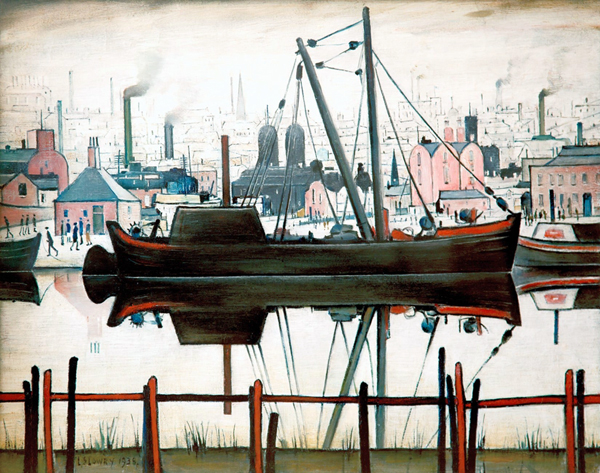
L. S. Lowry, The Coal Barge, 1938.
Goucher, C. L. 2007. African Metallurgy in the Atlantic World. In Archaeology of Atlantic Africa and the African Diaspora, edited by A. Ogundiran and T. Falola, 277–291. Bloomington: Indiana University Press.
Gradwohl, D. M., and N. M. Osborn. 1984. Exploring Buried Buxton: Archaeology of an Abandoned Iowa Coal Mining Town with a Large Black Population. Ames: Iowa State University Press.
Gramsci, A. 1971. Americanism and Fordism. In Selections from the Prison Notebooks of Antonio Gramsci, edited by Q. Hoare and G. N. Smith, 279–318. New York: International Publishers.
Grant, E. G. 1987. Industry: Landscape and Llocation. In Landscape and Culture: Geographical and Archaeological Perspectives, edited by J. M. Wagstaff, 96–117. Oxford, UK: Basil Blackwell.
Grant, H. R. 2004. “Follow the Flag”: A History of the Wabash Railroad Company. DeKalb: Northern Illinois University Press.
Greenwood, R. 1998. A Mechanic in the Garden: Landscape Design in Industrial Rhode Island. IA: Journal of the Society for Industrial Archeology 24(1): 9–18.
Greer, G. H. 1970. Preliminary Information on the Use of the Alkaline Glaze for Stoneware in the South, 1800-1970. Conference on Historic Sites Archaeology, Papers 5: 155–170.
Greer, G. H. 1977. Groundhog Kilns: Rectangular American Kilns of the Nineteenth and Early Twentieth Centuries. Northeast Historical Archaeology 34: 1–36.
Greer, G. H. 1981. American Stonewares, the Art and Craft of Utilitarian Potters. Exton, PA: Schiffer Publishing.
Grier, J. J., and L. Mercier (eds.) 2006. Mining Women: Gender in the Development of a Global Industry, 1670 to 2005. New York: Palgrave Macmillan.
Griggs, H. J. 2001. “By Virtue of Reason and Nature”: Competition and Economic Strategy in the Needletrades at New York’s Five Points, 1855-1880. Historical Archaeology 35(3): 76–88.
Griswold, W. A., and D. W. Linebaugh (eds.) 2010. Saugus Iron Works: The Roland W. Robbins Excavations, 1948-1953. Washington, DC: National Park Service.
Gross, L. F. 1981. The Importance of Research Outside the Library: Watkins Mill, a Case Study. IA: Journal of the Society for Industrial Archaeology 7(1): 15–26.
Gundy, B. J., and D. Casselberry. 2005. The Mansion Pottery. Ceramics in America 2005: 141–159.
Gurcke, K. 1987. Bricks and Brickmaking: A Handbook for Historical Archaeology. Moscow: University of Idaho Press.
Guroff, M. 2016. The Mechanical Horse: How the Bicycle Reshaped American Life. Austin: University of Texas Press.
Gutman, H. G. 1976. Work, Culture, and Society in Industrializing America: Essays in American Working-class and Social History. New York: Alfred A. Knopf.
Gwyn, D. 2009. An Amorphous Farrago? The Contribution of Industrial Archaeology. In Crossing Paths or Sharing Tracks? Future Directions in the Archaeological Study of Post-1550 Britain and Ireland, edited by A. Horning and M. Palmer, 19–30. Woodbridge, UK: Boydell Press.
Hahn, T. F., and E. L. Kemp. 1994. Cement Mills along the Potomac River. Monograph Series, Vol. 2, No. 1. Morgantown, WV: Institute for the History of Technology and Industrial Archaeology and West Virginia University.
Hamm, M., R. Steinberg, and R. Jungk. 1982. Dead Tech: A Guide to the Archaeology of Tomorrow. San Francisco, CA: Sierra Club Books.
Hall, G. M. 2005. Slavery and African Ethnicities in the Americas: Restoring the Links. Chapel Hill: University of North Carolina Press.
Hammer, T. J. 2011. Canyon City: The Archaeology of a Company Town on the Transportation Network to the Klondike. In Eldorado! The Archaeology of Gold Mining in the Far North, edited by C. H. Spude, R. O. Mills, K. Gurcke, and R. Sprague, 164-181. Lincoln: University of Nebraska Press and Society for Historical Archaeology.

Eyre Crowe, Dinner Hour, Wigan.
Hardesty, D. L. 1994. Class, Gender Strategies, and Material Culture in the Mining West. In Those of Little Note: Gender, Race, and Class in Historical Archaeology, edited by E. M. Scott, 129–145. Tucson: University of Arizona Press.
Hardesty, D. L. 1998a. The Archaeology of Mining and Miners. Society for Historical Archaeology Special Publication Series, No. 6. Pleasant Hill, CA: Society for Historical Archaeology.
Hardesty, D. L. 1998b. Power and the Industrial Mining Community in the American West. In Social Approaches to an Industrial Past: The Archaeology and Anthropology of Mining, edited by A. B. Knapp, V. C. Pigott, and E. Herbert, 81–96. New York: Routledge.
Hardesty, D. L. 2000. Speaking in Tongues: The Multiple Voices of Fieldwork in Industrial Archaeology. IA: Journal of the Society for Industrial Archaeology 26(2): 43–47.
Hardesty, D. L. 2010. Mining Archaeology in the American West: A View from the Silver State. Lincoln: University of Nebraska Press.
Hardesty, D. L. 2011. Theoretical Perspectives on the Frontier Mining Town. In Eldorado! The Archaeology of Gold Mining in the Far North, edited by C. H. Spude, R. O. Mills, K. Gurcke, and R. Sprague, 25-33. Lincoln: University of Nebraska Press and Society for Historical Archaeology.
Harrod, R. P., and J. J. Crandall. 2015. Rails Built of the Ancestors’ Bones: The Bioarchaeology of the Overseas Chinese Experience. Historical Archaeology 49(1): 148–161.
Hartley, E. N. 1957. Ironworks of the Saugus: The Lynn and Braintree Ventures of the Company of Undertakers of the Ironworks in New England. Norman: University of Oklahoma Press.
Hayes, B. 2014. Infrastructure: A Guide to the Industrial Landscape. New York: W. W. Norton and Co.
Hayman, R. 2005. Ironmaking: The History and Archaeology of the Iron Industry. Stroud, UK: Tempus.
Heberling, S. D. 2007. Industrial Archaeology in the Blacklog Narrows: A Story of the Juantiata Valley Iron Industry. Harrisburg: Pennsylvania Department of Transportation.
Heberling, S. D. 2015. The Archaeology of Failure: An Example from the Juniata Iron District of Pennsylvania. IA: Journal of the Society for Industrial Archaeology 41(1-2): 25–47.
Heffner S. C. 2015. Exploring Health-care Practices of Chinese Railroad Workers in North America. Historical Archaeology 49(1): 134–147.
Heite, E. F. 1974. The Delmarva Bog Iron Industry. Northeast Historical Archaeology 3(3): 18–34.
Henderson, J. 1858. On the Methods Generally Adopted in Cornwall, in Dressing Tin and Copper Ores. Minutes of the Proceedings of the Institution of Civil Engineers 17: 195–220.
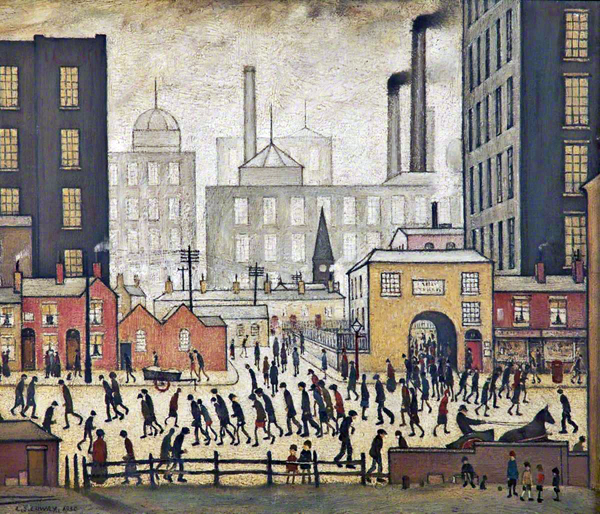
L. S. Lowry, Coming from the Mill, 1931.
Hewison, R. 1987. The Heritage Industry: Britain in a Climate of Decline. London: Methuen.
Hewiton, C. 2012. The Workman Laid Down His Tools: Approaches to the Recording and Analysis of Artefactual Remains in 19th and 20th Century Workshops. In Modern Materials, Studies in Contemporary and Historical Archaeology, vol. 8, edited by B. Fortenberry and L. McAtackney, 37–50. BAR International Series No. 2363. Oxford, UK: Archaeopress.
Hewitt, A. S. 1876. A Century of Mining and Metallurgy in the United States. Transactions of the American Institute of Mining Engineers 5: 164–196.
Hicks, B. 2014. Sea of Darkness: Unraveling the Mysteries of the H.L. Hunley. Ann Arbor, MI: Spry Publishing.
Hicks, B., and S. Kropf. 2003. Raising the Hunley: The Remarkable History and Recovery of the Lost Confederate Submarine. New York: Random House.
High, S., and D. W. Lewis. 2007. Corporate Wasteland: The Landscape and Memory of Deindustrialization. Ithaca, NY: Cornell University Press.
Hindle, B. (ed.) 1985. America’s Wooden Age: Aspects of Its Early Technology. New York: Sleepy Hollow Press.
Holcombe, J. L., and F. E. Holcombe. 1989. South Carolina Potters and Their Wares: The History of Pottery Manufacture in Edgefield District’s Big Horse Section, Part I (ca. 1810-1825). South Carolina Antiquities 21(1-2): 11–30.
Holcombe, J. L., and F. E. Holcombe. 1998. Archaeological Findings. In “I Made This Jar . . .” The Life and Works of the Enslaved African-American Potter, Dave, edited by J. B. Koverman, 72–81. Columbia: McKissick Museum, University of South Carolina.
Holloway, J. E. 1990. The Origins of African-American Culture. In Africanisms in American Culture, edited by J. E. Holloway, 1–18. Bloomington: Indiana University Press.
Holmes, Nicholas P., Daniel Sanabria, Gemma A. Calvert, and Charles Spence. 2007. Tool-use: Capturing Multisensory Spatial Attention or Extending Multisensory Peripersonal Space? Cortex 43(3): 469–489.
Holzberg, C. S., and M. J. Giovanni. 1981. Anthropology and Industry: Reappraisal and New Directions. Annual Review of Anthropology 10: 317–360.
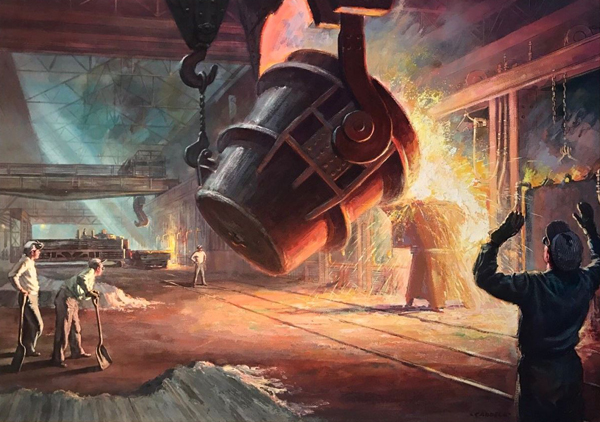
Foster Caddell, At the Open-hearth Furnace, 1940.
Hounshell, D. A. 1997. From the American System to Mass Production, 1800-1932: The Development of Manufacturing Technology in the United States. Baltimore, MD: Johns Hopkins University Press.
Hovis, L., and J. Mouat. 1996. Miners, Engineers, and the Transformations of Work in the Western Mining Industry, 1880-1930. Technology and Culture 37(3): 429–456.
Hsu, Y. 1995. Building and Firing Technique of Jingdezhen Ancient Wood Kiln. In Science and Technology of Ancient Ceramics 3: Proceedings of the International Symposium, edited by G. Jinkun, 286–290. Shanghai: Shanghai Research Society of Science and Technology of Ancient Ceramics.
Hudson, K. 1966. Industrial Archaeology: An Introduction. New York: Humanities Press.
Hudson, K. 1979. World Industrial Archaeology. Cambridge, UK: Cambridge University Press.
Hull-Walski, D. A., and F. L. Walski. 1994. There’s Trouble A-brewin’: The Brewing and Bottling Industries at Harpers Ferry, West Virginia. Historical Archaeology 28(4): 106–121.
Hunt, R. W. 1876. History of the Bessemer Manufacture in America. Transactions of the American Institute of Mining Engineers 5: 201–216.
Hunter, R., and O. Mueller-Heubach. 2019. Visualizing the Stoneware Potteries of William Rogers of Yorktown and Abner Landrum of Pottersville. Ceramics in America 2019: 112–134.
Hunter, R. W., and I. C. Burrow. 2010. Steel Away: The Trenton Steel Works and the Struggle for American Manufacturing Independence. In Footprints of Industry: Papers from the 300th Anniversary Conference at Coalbrookdale, edited by P. Belford, M. Palmer, and R. White, 69–88. Oxford, UK: Archaeopress.
Hunter, W. M. 2014. A Cultural Historic Survey for the Hawks Nest-Glen Ferris Hydroelectric Projects, Fayette County, West Virginia. Contract Publication Series 13-289. Hurricane, WV: Cultural Resource Analysts.
Husband, J. 1917. The Story of the Pullman Car. Chicago: A. C. McClurg and Co.
Iles, L. 2016. The Role of Metallurgy in Transforming Global Forests. Journal of Archaeological Theory and Method 23: 1219-1241.
Ingold, T., and T. Kurttila. 2000. Perceiving the Environment in Finnish Lapland. Body and Society 6(3-4): 183–196.
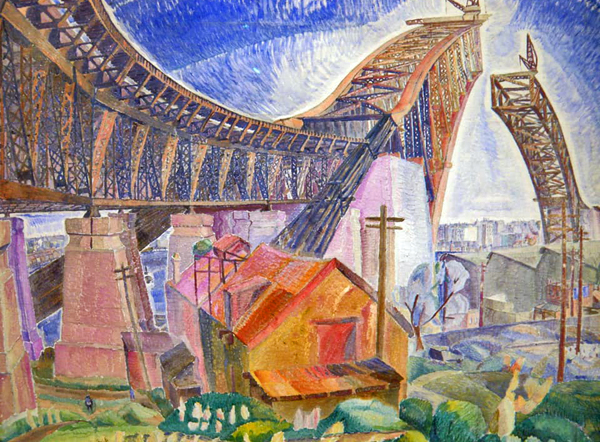
Grace Cossington Smith, The Bridge in Curve, 1930 (Sydney).
Innes, S. 1995. Creating the Commonwealth: The Economic Culture of Puritan New England. New York: W. W. Norton.
International Council on Monuments and Sites (ICOMOS). 2011. Joint ICOMOS-TICCIH Principles for the Conservation of Industrial Heritage Sites, Structures, Areas, and Landscapes. Adopted by the 17th ICOMOS General Assembly, November 28.
Jenks, L. H. 1944. Railroads as an Economic Force in American Development. Journal of Economic History 4(1): 1–20.
Jenks, L. H. 1951. Capital Movement and Transportation: Britain and American Railway Development. Journal of Economic History 11(4): 375–388.
Jervis, J. B. 1861. Railway Property: A Treatise on the Construction and Management of Railways. New York: Phinney, Blakeman and Mason.
Johnson, D. 2021. Brickmaking: History and Heritage. Stroud, UK: Amberley Publishing.
Johnson, M. 1995. A Nineteenth-century Mill Village: Virginius Island, 1800-60. West Virginia History 54: 1–27.
Johnson, M. 1996. An Archaeology of Capitalism. New York: Wiley-Blackwell.
Johnston, A. S. 2013. Mercury and the Making of California: Mining, Landscape, and Race, 1840-1890. Boulder: University Press of Colorado.
Jones, H. M. 1970. The Age of Energy: Varieties of American Experience. New York: Viking Press.
Jones, O., and C. Sullivan. 1989. The Parks Canada Glass Glossary for the Description of Containers, Tableware, Flat Glass, and Closures. Ottawa: National Historic Parks and Sites, Canadian Parks Service.
Jones, W. 2006. Dictionary of Industrial Archaeology, 2d ed. Stroud, UK: Sutton Publishing.
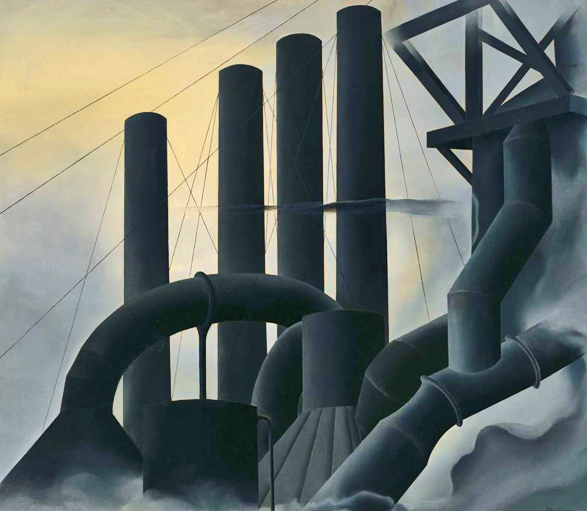
Elsie Driigs, Pittsburgh, 1927.
Joseph, J. W. 2011. “All of Cross” – African Potters, Marks, and Meanings of Folk Pottery in Edgefield District, South Carolina. Historical Archaeology 45(2): 134–155.
Joseph, J. W. 2016. Marks from the Past, Signs of the Future – the Dikenga of Historical Archaeology. Historical Archaeology 50(3): 5–23.
Joseph, J. W. 2017. Crosses, Crescents, Slashes, Stars: African American Potters and Edgefield District Pottery Marks. Journal of African Diaspora Archaeology and Heritage 6(2): 110–132.
Joseph, J. W., and N. Isenbarger. 2011. Marks in Common: Current Research on African American Marks on Colonoware and Edgefield. South Carolina Antiquities 43: 80.
Joseph, J. W., and M. Zierden (eds.) 2001. Another’s Country: Archaeological and Historical Perspectives on Cultural Interactions in the Southern Colonies. Tuscaloosa: University of Alabama Press.
Kaufman, B. 2018. Anthropology of Metallurgical Design: A Survey of Metallurgical Traditions from Hominin Evolution to the Industrial Revolution. In Metallurgical Design and Industry: Prehistory to the Space Age, edited by B. Kaufman and C. L. Briant, 1-70. Cham, Switzerland: Springer International Publishing.
Keller, C. M., and J. D. Keller. 2008. Cognition and Tool Use: The Blacksmith at Work. Cambridge, UK: Cambridge University Press.
Kelly, S. E. 2013. The Role of Technological Transitions in the Development of American Ceramic Industries: Elijah Cornell and the Shift from Redware to Stoneware Production. Historical Archaeology 47(4): 45–70.
Kelso, W. M. 2006. Jamestown: The Buried Truth. Charlottesville: University of Virginia Press.
Kelso, W. M., and E. A. Chappell. 1974. Excavation of a Seventeenth Century Pottery Kiln at Glebe Harbor, Westmoreland County, Virginia. Historical Archaeology 8: 53–63.
Kemp, E. L. 1996a. The Dioscuri: Industrial Archaeology and the History of Technology. In Industrial Archaeology: Techniques, edited by E. L. Kemp, 1–5. Malabar, FL: Krieger Publishing Co.
Kemp, E. L. 1996b. The Shepherdstown Cement Mill: A Case Study. In Industrial Archaeology: Techniques, edited by E. L. Kemp, 7–39. Malabar, FL: Krieger Publishing Co.
Kemp, E. L., and M. W. Caplinger. 2007. 19th Century Petroleum Technology in North America. Morgantown, WV: Institute for the History of Technology and Industrial Archaeology, West Virginia University.
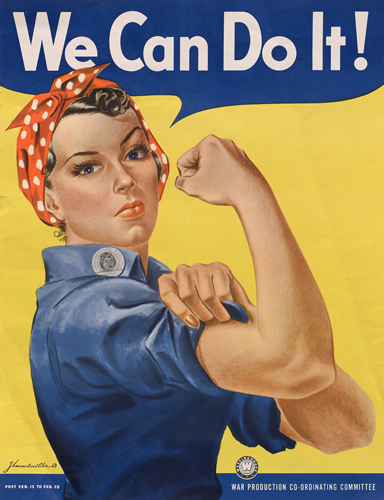
Rosie the Riveter poster, J. Howard Miller, 1942.
Kenline, B. 2011. Searching for Enslaved Laborers at the Reverend John Landrum Site (38AK497). South Carolina Antiquities 43: 78–79.
Kenline, B. 2012. Capitalist Entrepreneurs and Industrial Slavery in the Rural Antebellum South. Master’s Thesis, Department of Anthropology, University of South Carolina, Columbia.
Kenline-Nyman, B. 2017. Manufacturing Social Class: Entrepreneurs and Industrial Slavery in the Rural Antebellum South. Journal of African Diaspora Archaeology and Heritage 6(2): 155–169.
Kennedy, J. R. 2015. Zooarchaeology, Localization, and Chinese Railroad Workers in North America. Historical Archaeology 49(1): 122–133.
Kennedy, J. R., S. Heffner, V. Popper, R. P. Harrod, and J. J. Crandall. 2019. The Health and Well-being of Chinese Railroad Workers. In The Chinese and the Iron Road: Building the Transcontinental Railroad, edited by G. H. Chang and S. F. Fishkin, 139–158. Stanford, CA: Stanford University Press.
Klein, N. 2007. The Shock Doctrine: The Rise of Disaster Capitalism. New York: Metropoloitan Books.
Kleinpenning, G., and L. Hagendoorn. 1993. Forms of Racism and the Cumulative Dimension of Ethnic Attitudes. Social Psychology Quarterly 56(1): 21–26.
Knapp, A. B., and V. Pigott. 1997. The Archaeology and Anthropology of Mining: Social Approaches to an Industrial Past. Current Anthropology 38(2): 300–304.
Knight, F. C. 2010. “Slave Artisans: Black Nonagricultural Workers in Colonial America and the Antebellum South.” In F. C. Knight, Working the Diaspora: The Impact of African Labor on the Anglo-American World, 1650-1850, 111-129. New York: NYU Press.
Kornweibel, T., Jr. 2010. Railroads in the African American Experience: A Photographic Journey. Baltimore, MD: Johns Hopkins University Press.
Kovel, J. 1970. White Racism: A Psychohistory. New York: Pantheon Books.
Koverman, J. B. 1998. Dave’s Verse as Social Response. In “I Made this Jar . . .” The Life and Works of the Enslaved African-American Potter, Dave, edited by J. B. Koverman, 82–92. Columbia: McKissick Museum, University of South Carolina.
Kuo, S. C., and R. Minor. 2016. The Oswego Furnace: Industrial Archaeology at the First Iron Works on the Pacific Coast. IA: Journal of the Society for Industrial Archaeology 42(1): 37–54.
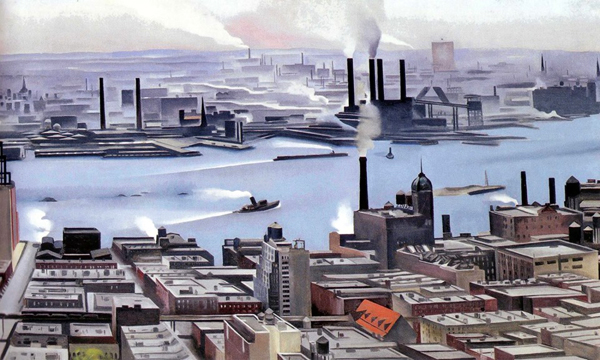
Georgia O’Keeffe, East River from the 30th Story of the Shelton Hotel, 1928.
Lancianese, A. 2019. Before Black Lung, the Hawks Nest Tunnel Disaster Killed Hundreds. NPR News, Jan. 20, Washington, DC. https://www.npr.org/2019/01/20/685821214/before-black-lung-the-hawks-nest-tunnel-disaster-killed-hundreds.
Landes, D. S. 2000. Revolution in Time: Clocks and the Making of the Modern World. Cambridge, MA: Belknap.
Landes, D. S. 2003. The Unbound Prometheus: Technological Change and Industrial Development in Western Europe from 1750 to the Present. Cambridge, UK: Cambridge University Press.
Landon, D. B. 1999. Interpreting Social Organization at Industrial Sites: An Example from the Ohio Trap Rock Mine. Northeast Historical Archaeology 28(1): 89–103.
Landon, D. B., and T. Tumberg. 1996. Archaeological Perspectives on the Diffusion of Technology: An Example from the Ohio Trap Rock Mine Site. IA: Journal of the Society for Industrial Archaeology 22(2): 40–57.
Landrum, Abner. 1830. Editorial. Edgefield Hive. Edgefield, SC.
Langhorne, W. T., Jr. 1976. Mill Based Settlement Patterns in Schoharie County, New York: A Regional Study. Historical Archaeology 10: 73–92.
Langlands, A. 2018. Craeft: An Inquiry into the Origins and True Meaning of Traditional Crafts. New York: W. H. Norton and Co.
Lankton, L. D. 1991. Cradle to Grave: Life, Work, and Death at the Lake Superior Copper Mines. New York: Oxford University Press.
Lawrence, S. 2022. Gold Rush Archaeology: Gold and Silver Mining around the Pacific Rim. In Oxford Handbook of Industrial Archaeology, edited by E. C. Casella, M. Nevell, and H. Steyne, pp. 1-17. London: Oxford University Press.
Lawrence, S., and P. Davies. 2015. Innovation, Adaptation and Technology as Habitus: The Origins of Alluvial Gold Mining Methods in Australia. Archaeology in Oceania 50(Supp.): 20–29.
Lawrence, S., and P. Davies. 2018. Archaeology and the Anthropocene in the Study of Settler Australia. In Historical Archaeology and the Environment, edited by M. A. T. de Souza and D. M. Costa, 229–251. New York: Springer.
Lemonnier, P. 1986. The Study of Material Culture Today: Toward an Anthropology of Technical Systems. Journal of Anthropological Archaeology 5: 147–186.
Lemonnier, P. 1993. Introduction. In Technological Choices: Transformations in Material Cultures since the Neolithic, edited by P. Lemonnier, 1–35. London: Routledge.
Leone, M. P., C. J. LaRoche, and J. J. Barbiarz. 2005. The Archaeology of Black Americans in Recent Times. Annual Review of Anthropology 34: 575–598.
Lesley, J. P. 1859. The Iron Manufacturer’s Guide to the Furnaces, Forges and Rolling Mills of the United States, with Discussions of Iron as a Chemical Element, an American Ore, and a Manufactured Article, in Commerce and in History. New York: John Wiley.
Levi, A. W. 1967. Existentialism and the Alienation of Man. In Phenomenology and Existentialism, edited by E. N. Lee and M. Mandalbaum, 243–265. Baltimore, MD: Johns Hopkins Press.
Levinson, M. 2006. The Box: How the Shipping Container Made the World Smaller and the World Economy Bigger. Princeton, NJ: Princeton University Press.
Lewis, R. L. 1979. Coal, Iron, and Slaves: Industrial Slavery in Maryland and Virginia, 1715-1865. Westport, CT: Greenwood Press.
Lewis, W. D. 2011. Sloss Furnaces and the Rise of the Birmingham District: An Industrial Epic. Tuscaloosa: University of Alabama Press.
Light, J. D. 2007. A Dictionary of Blacksmithing Terms. Historical Archaeology 41(2): 84–157.
Lindner, C., and B. Rosa (eds.) 2017. Deconstructing the High Line: Postindustrial Urbanism and the Rise of the Elevated Park. New Brunswick, NJ: Rutgers University Press.
Lindsey, B. (ed.) 2018. Historic Glass Bottle Identification and Information, Society for Historical Archaeology. https://sha.org/bottle/.
Livesay, H. C. 2007. Andrew Carnegie and the Rise of Big Business. New York: Pearson Longman.
Longfellow, H. W. 1878. King-te-tching. In Poems of Places, Vol. 23, Asia: Persia, India, Chinese Empire, Japan, edited by H. W. Longfellow, 212. Boston, MA: Houghton, Osgood and Co.
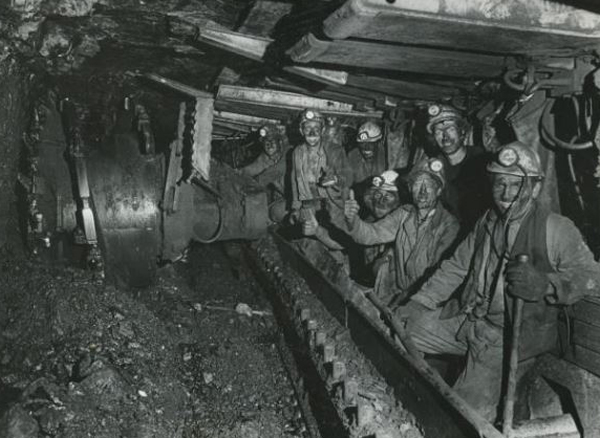
Faceworkers, Oakdale Coal Mine.
Mackay, C. 1846. Railways. In Voices from the Crowd; and Other Poems. London: W. S. Orr.
Madison, N. V. 2015. Tredegar Iron Works: Richmond’s Foundry on the James. Charleston, SC: History Press.
Maier, P., M. R. Smith, A. Keyssar, and D. L. Kevles. 2006. Inventing America: A History of the United States. New York: W. W. Norton and Co.
Majewski, J. 2009. Modernizing a Slave Economy: The Economic Vision of the Confederate Nation. Chapel Hill: University of North Carolina Press.
Malone, J. M., G. H. Greer, and H. Simons. 1979. Kirbee Kiln: A Mid-nineteenth-century Texas Stoneware Pottery. Office of the State Archaeology Report 31. Office of the State Archaeologist, Texas Historical Commission.
Malone, P. M. 2009. Waterpower in Lowell: Engineering and Industry in Nineteenth-century America. Baltimore, MD: Johns Hopkins University Press.
Maniery, M. L., R. Allen, and S. C. Heffner. 2016. Finding Hidden Voices of the Chinese Railroad Workers: An Archaeological and Historical Journey. Special Publication Series No. 13. Germantown, MD: Society for Historical Archaeology.
Mansberger, F. R. 1997. Early Industrialized Pottery Production in Illinois: Archaeological Investigations at White and Company’s Gooselake Stoneware Manufactory and Tile Works, Rural Grundy County, Illinois. Springfield: Illinois State Museum Society.
Marcoux, J. B., and E. C. Poplin. 2017. The Archaeology of the Wood Pottery: Confounding the “Industrial” Transformation of Southern Stoneware Production after Edgefield. Historical Archaeology 51(4): 506–530.
Margrave, R. D. 1975. The Role of the Paterson, NJ Silk Industry in the 19th-century Atlantic Economy. Northeast Historical Archaeology 4(1): 53–58.
Marshall, P. P., and J. R. Leimenstoll. 2010. Thomas Day: Master Craftsman and Free Man of Color. Chapel Hill: University of North Carolina Press.
Martin, P. E. 2009. Industrial Archaeology. In International Handbook of Historical Archaeology, edited by T. Majewski and D. Gaimster, 285–297. New York: Springer.
Martin, P. E. 2012. Industrial Archaeology. In Industrial Heritage Re-tooled: The TICCIH Guide to Industrial Heritage Conservation, edited by J. Douet, 40–47. Lancaster, UK: The International Committee for the Conservation of the Industrial Heritage.
Marx, K. 1867. Capital: A Critique of Political Economy, vol. 1. New York: International Publishers (1967 reprint).

Berenice Abbott, photographer, Woman Wiring an Early IBM Computer, 1938-58 series.
McCusker, J. J., and R. R. Menard. 1985. The Economy of British America, 1607-1789. Chapel Hill: University of North Carolina Press.
McDavid, C. 1997. Descendants, Decisions, and Power: The Public Interpretation of the Archaeology of the Levi Jordan Plantation. Historical Archaeology 31(3): 114–131.
McGuire, R. H., and P. Reckner. 2002. The Unromantic West: Labor, Capital, and Struggle. Historical Archaeology 36(3): 44–58.
McKearin, H. 1970. Bottles, Flasks, and Dr. Dyott. New York: Crown Publishers.
McKee, H. J. (comp.) 1970. Recording Historic Buildings, Historic American Buildings Survey. Washington, DC: U.S. Department of the Interior and National Park Service.
McLaughlin, K. 2020. A Once-powerful Montana Mining Town Warily Awaits Final Clean-up of Its Toxic Past. Washington Post, Feb. 10. https://www.washingtonpost.com.
McNeary, R. W. A. 2007. “Guns, Harpoons, Lances, Casks and Every [Necessary] Article”; An Account of the History and Archaeology of an Eighteenth-century Shore-based Whaling and Basking Shark Fishery in Donegal Bay. Historical Archaeology 41(3): 115–124.
McVarish, D. C. 2008. American Industrial Archaeology. Walnut Creek, CA: Left Coast Press.
Means, B. (ed.) 1999. A Community Digs Its Past: The Lee Street Site. Alexandria Archaeology Publication No. 122. Alexandria, VA: Alexandria Archaeology Museum.
Meniketti, M. G. 2016. The Timber Industry of the Early San Franciso Bay Region: Archaeology at the Loma Prieta Mill Site. IA: Journal of the Society for Industrial Archaeology 42(2): 35–54.
Metheny, K. B. 2007. From the Miners’ Doublehouse: Archaeology and Landscape in a Pennsylvania Coal Company Town. Knoxville: University of Tennessee Press.
Mickel, A. 2019. Essential Excavation Experts: Alienation and Agency in the History of Archaeological Labor. Archaeologies: Journal of the World Archaeological Congress 15(2): 181–205.
Miller, G. L., and C. Sullivan. 1984. Machine-made Glass Containers and the End of Production for Mouth-blown Bottles. Historical Archaeology 18: 83–96.
Miller, J. A. 1998. Dave the Potter and the Origins of African-American Poetry. In “I Made This Jar . . .” The Life and Works of the Enslaved African-American Potter, Dave, edited by J. B. Koverman, 53–60. Columbia: McKissick Museum, University of South Carolina.
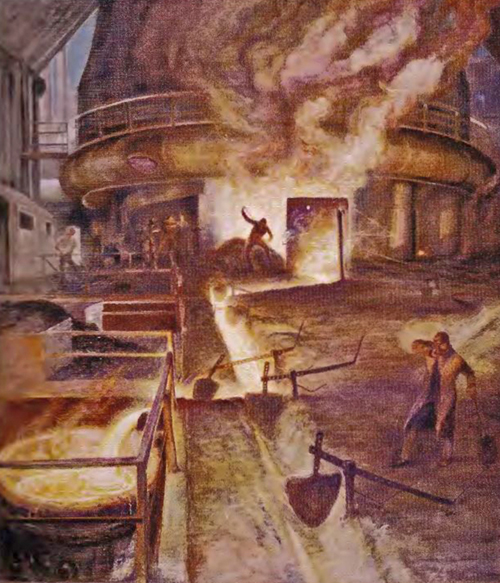
Edmund Marion Ashe, The Cast, 1939.
Mills, R. 1825. Atlas of the State of South Carolina. Baltimore, MD: F. Lucas.
Mills, R. 1826. Statistics of South Carolina. Charleston, SC: Hurlbut and Lloyd.
Mills, R. O. 2011. A Proposed Model for a Placer Gold Mining Settlement System. In Eldorado! The Archaeology of Gold Mining in the Far North, edited by C. H. Spude, R. O. Mills, K. Gurcke, and R. Sprague, 34-49. Lincoln: University of Nebraska Press and Society for Historical Archaeology.
Mirsky, J., and A. Nevins. 1952. The World of Eli Whitney. New York: Macmillan.
Molenda, J. 2015. Moral Discourse and Personhood in Overseas Chinese Contexts. Historical Archaeology 49(1): 46–58.
Monroe, J. C., and S. Mallios. 2004. A Seventeenth-century Colonial Cottage Industry: New Evidence and a Dating Formula for Colono Tobacco Pipes in the Chesapeake. Historical Archaeology 38(2): 68–82.
Montgomery, C. J. 1908. Survivors from the Cargo of the Negro Slave Yacht Wanderer. American Anthropologist 10(4): 611–623, with a note by Frederick Starr.
Mooney, C. A., A. L. Hynes, and M. M. Newell. 2013. African-American Face Vessels: History and Ritual in 19th-Century Edgefield. Ceramics in America 2013: 2–37.
Moore, J. W. 2015. Capitalism in the Web of Life: Ecology and the Accumulation of Capital. London: Verso.
Moore, J. W. (ed.) 2016. Anthropocene or Capitalocene? Nature, History and the Crisis of Capitalism. Oakland, CA: PM Press.
Morin, B. F. 2013. The Legacy of American Copper Smelting: Industrial Heritage Versus Environmental Policy. Knoxville: University of Tennessee Press.
Morrison, K. D. 2013. The Human Face of the Land: Why the Past Matters for India’s Environmental Future. NMML Occasional Paper, History and Society new ser., 27: 1–31.
Morton, T. 2013. Hyperobjects: Philosophy and Ecology after the End of the World. Minneapolis: University of Minnesota Press.
Moser, J. D. 2013. A Phase I Archaeological Identification Survey for the Existing Hawks Nest–Glenn Ferris Hydroelectric Project (FERC Project No. 2512), Fayette County, West Virginia. Contract Publication Series 13-244. Hurricane, WV: Cultural Resource Analysts.
Moshenska, G. 2016. Reverse Engineering and the Archaeology of the Modern World. Forum Kritische Archäologie 5: 16–28.
Moyer, T. S., and P. A. Shackel. 2008. The Making of Harpers Ferry National Historic Park: A Devil, Two Rivers, and a Dream. Lanham, MD: AltaMira Press.
Mrozowski, S. A. 1991. Landscapes of Inequality. In The Archaeology of Inequality, edited by R. H. McGuire and R. Paynter, 79–101. Oxford, UK: Basil Blackwell.
Mrozowski, S. A. 2006. The Archaeology of Class in Urban America. London: Cambridge University Press.
Mrozowski, S. A. 2018. The Archaeology of Climate Change: Is Unbridled Commodity Production Sustainable? In Historical Archaeology and the Environment, edited by M. A. T. de Souza and D. M. Costa, 41–61. New York: Springer.
Mrozowski, S. A., and M. C. Beaudry. 1990. Archaeology and the Landscape of Corporate Ideology. In Earth Patterns: Essays in Landscape and Archaeology, edited by W. M. Kelso and R. Most, 189–208. Charlottesville: University Press of Virginia.
Mrozowski, S. A., G. H. Ziesing, and M. C. Beaudry. 1996. Living on the Boott: Historical Archaeology at the Boott Mills Boardinghouses of Lowell, Massachusetts. Amherst: University of Massachusetts Press.
Mueller-Heubach, O. M. 2013. From Kaolin to Claymount: Landscapes of the 19th-century James River Stoneware Industry. Ph.D. Dissertation, Department of Anthropology, College of William and Mary, Williamsburg, Virginia.
Mullins, P. R. 2012. The Archaeology of Consumer Culture. Gainesville: University Press of Florida.
Muntz, A. 1960. Forests and iron: the charcoal iron industry of the New Jersey Highlands. Geografiska Annaler 42: 315–323.
Murphy, P., and P. E. Wiltshire (eds.) 2003. The Environmental Archaeology of Industry. Symposia of the Association for Environmental Archaeology, No. 20. Oxford, UK: Oxbow.
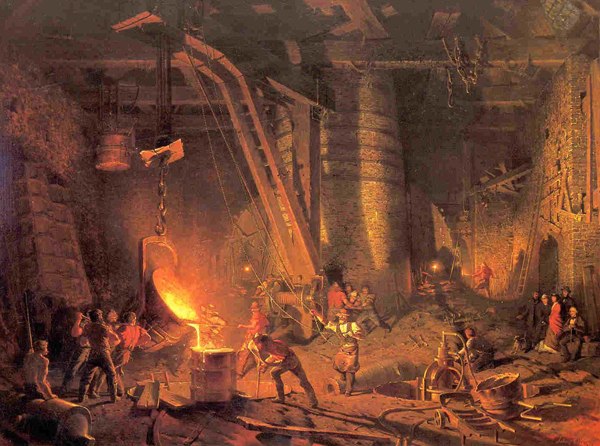
John Ferguson Weir, The Gun Foundry at West Point Foundry, 1866.
Nance, R. D. 2019. Cornish Mining Technology in Eastern Pennsylvania: The Perkiomen and Wheatley Mines. Mining History Journal 26: 1–20.
Nassaney, M. S. 2015. The Archaeology of the North American Fur Trade. Gainesville: University Press of Florida.
Nassaney, M. S. (ed.) 2019. Fort St. Joseph Revealed: The Historical Archaeology of a Fur Trading Post. Gainesville: University Press of Florida.
Nassaney, M. S., and M. R. Abel. 2000. Urban Spaces, Labor Organization and Social Control: Lessons from New England’s Nineteenth-century Cutlery Industry. In Lines that Divide: Historical Archeology of Race, Class, and Gender, edited by J. A. Delle, S. A. Mrozowski, and R. Paynter, 239–275. Knoxville: University of Tennessee Press.
National Energy Technology Laboratory (NETL) 2020. Rediscovery of Abandoned Wells in the World’s First Oil Field: Historical Review and Evaluation of Methods to Map and Measure Methane Emissions from Abandoned Wells. Washington, DC: National Energy Technology Laboratory, U.S. Department of Energy. https://netl.doe.gov/node/9367.
National Park Service (NPS). 1992. Lowell: The Story of an Industrial City. A Guide to Lowell National Historical Park and Lowell Heritage State Park, Lowell, Massachusetts. Official National Park Handbook 140. Washington, DC: National Park Service, U.S. Department of the Interior.
Needham, J., H. Ping-Yu, L. Gwei-djen, and L. Wang. 2004. Chemistry and Chemical Technology, Part 12: Ceramic Technology. Vol. V: Science and Civilization in China. Cambridge, UK: Cambridge University Press.
Niculescu, T. 2017. Tides of Celadon: Glaze Color Chronology from the Edgefield Pottery District, South Carolina. Journal of African Diaspora Archaeology and Heritage 6(3): 196–224.
Nimkulrat, N. 2012. Hands-on Intellect: Integrating Craft Practice into Design Research. International Journal of Design 6(3): 1-14.
Noël Hume, I. 1976. Archaeological Excavations on the Site of John Frederick Amelung’s New Bremen Glassmanufactory, 1962-1963. Journal of Glass Studies, special issue, 18: 138–214.
Nye, D. E. 1994. American Technological Sublime. Cambridge, MA: MIT Press.
Obermayr, E., and R. W. McQueen. 2016. Historical Archaeology in the Cortez Mining District: Under the Nevada Giant. Reno: University of Nevada Press.
O’Connor, R. 1997. Perfecting the “Iron Lung”: Making the New Window Glass Technology Work. IA: Journal of the Society for Industrial Archaeology 23(1): 6–24.
O’Dell, G. A., and A. I. George. 2014. Rock-shelter Saltpeter Mines of Eastern Kentucky. Historical Archaeology 48(2): 91–121.
Oevermann, H. 2021. Urban Textile Mills: Conservation and Conversion. Berlin-Brandenburg: Berlin-Brandenburg Wissenschaft Verlag.
Oevermann, H., B. M. Walczak, and M. Watson. 2022. The Heritage of the Textile Industry Lodz: TICCIH and Lodz University of Technology.
Okada, M. 2012. Industrial Ruins. In Industrial Heritage Rre-tooled: The TICCIH Guide to Industrial Heritage Conservation, edited by J. Douet, 149–154. Lancaster, UK: The International Committee for the Conservation of the Industrial Heritage.
Olalde, M., and R. Menezes. 2020. Deserted Oil Wells Haunt Los Angeles with Toxic Fumes and Enormous Cleanup Costs. Los Angeles Times, March 5. https://www.latimes.com.
Omi, M., and H. Winant. 1994. Racial Formation in the United States: From the 1960s to the 1990s. New York: Routledge.
Orange, H. 2008. Industrial Archaeology: Its Place within the Academic Discipline, the Public Realm and the Heritage Industry. Industrial Archaeology Review 30(2): 83–95.
Orange, H. 2015. Introduction. In Reanimating Industrial Spaces: Conducting Memory Work in Post-industrial Societies, edited by H. Orange, 13–27. Walnut Creek, CA: Left Coast Press.
O’Rourke, D. 2000. Archaeological Assessment of the Pullman Water Tower Foundation and the 11030 South Langley Property, Chicago, Cook County, Illinois. Department of Anthropology, University of Illinois at Chicago, and Public Service Archaeology Program, University of Illinois at Urbana-Champaign.
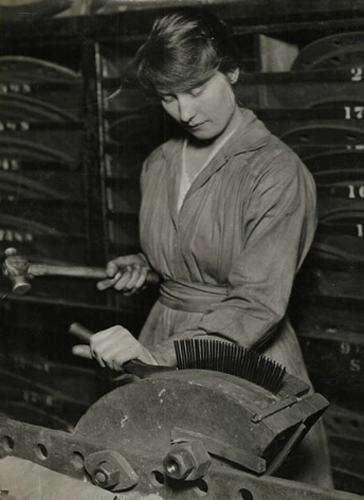
Forming Up Blading, WWI, Parsons Engineering Works,
Newcastle-Upon-Tyne, C. Tyne and Wear Archive.
Orser, C. E., Jr. 1996. A Historical Archaeology of the Modern World. New York: Plenum Press.
Orser, C. E., Jr. 2001. Race and the Archaeology of Identity in the Modern World. In Race and the Archaeology of Identity, edited by C. E. Orser, Jr., 1–13. Salt Lake City, UT: University of Utah Press.
Orser, C. E., Jr. 2004. Race and Practice in Archaeological Interpretation. Philadelphia: University of Pennsylvania Press.
Osuriak, Francois, Christoph Jarry, and Didier Le Gall. 2010. Grasping the Affordances, Understanding the Reasoning: Toward a Dialectical Theory of Human Tool Use. Psychological Review 117(2): 517-40.
Overbeck, R. A. 1996. Federal Records/Federal Repositories. In Industrial Archaeology: Techniques, edited by E. L. Kemp, 41–48. Malabar, FL: Krieger Publishing Co.
Palka, E. J. 1995. Company Stores of the Hocking Valley Coal Field: Fading Memories from a Bygone Era. Mining History Journal 2: 35–46.
Palmer, A. 2016. This Segregated Railway Car Offers a Visceral Reminder of the Jim Crow Era. Smithsonian Magazine June 13. https://www.smithsonianmag.com.
Palmer, M. 2000. Archaeology or Heritage Management: The Conflict of Objectives in the Training of Industrial Archaeologists. IA: Journal of the Society for Industrial Archaeology 26(2): 49–54.
Palmer, M. 2005. Industrial Archaeology: Constructing a Framework of Inference. In Industrial Archaeology: Future Directions, edited by E. C. Casella and J. Symonds, 59–75. New York: Springer.
Palmer, M. 2022. Conclusion: Industrial Archaeology: Past, Present, and Future. In Oxford Handbook of Industrial Archaeology, edited by E. C. Casella, M. Nevell, and H. Steyne, pp. 700-718. London: Oxford University Press.
Palmer, M., and P. Neaverson. 1998. Industrial Archaeology: Principles and Practice. London: Routledge.
Palmer, M., and H. Orange. 2016. The Archaeology of Industry: People and Places. Post-Medieval Archaeology 50(1): 73–91.
Pannell, J. P. 1966. The Techniques of Industrial Archaeology. Newton Abbot, UK: David and Charles, Ltd.
Parenti, C. 2016. Environment-making in the Capitalocene: Political Ecology of the State. In Anthropocene or Capitalocene? Nature, History and the Crisis of Capitalism, edited by J. W. Moore, 166–184. Oakland, CA: PM Press.
Parks, J. A. 2018. Stronger Than Steel: Forging a Rust Belt Renaissance. Bethlehem, PA: Rocky Rapids Press.
Pastron, A. G., and J. P. Delgado. 1991. Archaeological Investigations of a Mid-19th-century Shipbreaking Yard, San Francisco, California. Historical Archaeology 25(3): 61–77.
Paynter, R. 1988. Steps to an Archaeology of Capitalism: Material Change and Class Analysis. In The Recovery of Meaning: Historical Archaeology in the Eastern United States, edited by M. P. Leone and P. B. Potter, Jr., 407–434. Washington, DC: Smithsonian Institution Press.
Pechin, E. C. 1872. The Position of the American Pig-iron Manufacture. Transactions of the American Institute of Mining Engineers 1: 277–287.
Pepper, A. 1971. The Glass Gaffers of New Jersey and Their Creations from 1739 to the Present. New York: Charles Scribner’s Sons.
Pettem, S. 2002. Cornish Heritage Buried on the American Frontier. Mining History Journal 9: 9–11.
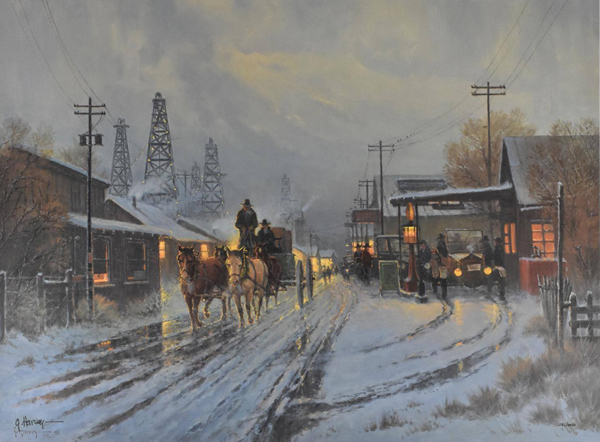
G. Harvey, Independent Oilmen.
Pezzarossi, G. 2019. Introduction: Rethinking the Archaeology of Capitalism: Coercion, Violence, and the Politics of Accumulation. In “Rethinking the Archaeology of Capitalism,” special issue edited by G. Pezzarossi. Historical Archaeology 53(3-4): 453–467.
Pfaffenberger, B. 1998. Mining Communities, Chaînes Opératoires and Sociotechnic Systems. In Social Approaches to an Industrial Past: The Archaeology and Anthropology of Mining, edited by A. B. Knapp, V. C. Pigott, and E. Herbert, 291–300. New York: Routledge.
Pittaway, M. 2005. Creating and Domesticating Hungary’s Socialist Industrial Landscape: From Dunapentele to Sztálinváros, 1950-1958. Historical Archaeology 39(3): 75–93.
Polk, M. R. 2015. Interpreting Chinese Worker Camps on the Transcontinental Railroad at Promontory Summit, Utah. Historical Archaeology 49(1): 59–70.
Polk, M. R. 2021. Railroads and the Historic Resources to Understand their Significance. Paper Presented at the Society for Historical Archaeology 2021 Virtual Conference, Jan. 6-9.
Porcher, R. D., Jr., and W. R. Judd. 2014. The Market Preparation of Carolina Rice: An Illustrated History of Innovations in the Lowcountry Rice Kingdom. Columbia: University of South Carolina Press.
Quivik, F. L. 2000. Landscapes as Industrial Artifacts: Lessons from Environmental History. IA: Journal of the Society for Industrial Archaeology 26(2): 55–64.
Quivik, F. L. 2017. Butte and Anaconda, Montana: Preserving and Interpreting a Vast Landscape of Extraction. Change Over Time 7(1): 6–28.
Quivik, F. L. 2022. Butte and Anaconda, Montana: Industrial Waste as Industrial Heritage. In Oxford Handbook of Industrial Archaeology, edited by E. C. Casella, M. Nevell, and H. Steyne, pp. 341-356. London: Oxford University Press.
Raber, M. S., P. M. Malone, and R. B. Gordon. 1992. Historical and Archaeological Assessment of the Tredegar Iron Works Site, Richmond, Virginia. Report for the Valentine Museum and Ethyl Corporation, submitted by Raber Associates, Richmond, Virginia.
Raber, M. S., P. M. Malone, R. B. Gordon, and C. C. Cooper. 1989. Conservative Innovators and Military Small Arms: An Industrial History of the Springfield Armory, 1794-1968. Report for the National Park Service, United States Department of the Interior, submitted by Raber Associates, South Glastonbury, Connecticut.
Raber, M. S., P. M. Malone, R. B. Gordon, and C. C. Cooper. 2008. Forge of Innovation: An Industrial History of the Springfield Armory, 1794-1968. Springfield, MA: Eastern National.
Raimi, D. 2017. The Fracking Debate: The Risks, Benefits, and Uncertainties of the Shale Revolution. New York: Columbia University Press.
Rainsford, B. C., and A. F. Goldberg. 2011. A Celebration of Edgefield Pottery. Ars Ceramica 27: 44–57.
Ramenofsky, A. F., C. D. Vaughan, and M. N. Spilde. 2008. Seventeenth-century Metal Production at San Marcos Pueblo, North-central New Mexico. Historical Archaeology 42(4): 105–131.
Reber, S. C., and M. R. Smith. 1986. Contextual Contrasts: Recent Trends in the History of Technology. In High-Technology Ceramics: Past, Present, and Future, edited by W. D. Kingery, pp. 1-15. Westerville, Ohio: American Ceramic Society.
Reiff, J. L., and S. E. Hirsch. 1989. Pullman and Its Public: Image and Aim in Making and Interpreting History. Public Historian 11(4): 99–112.
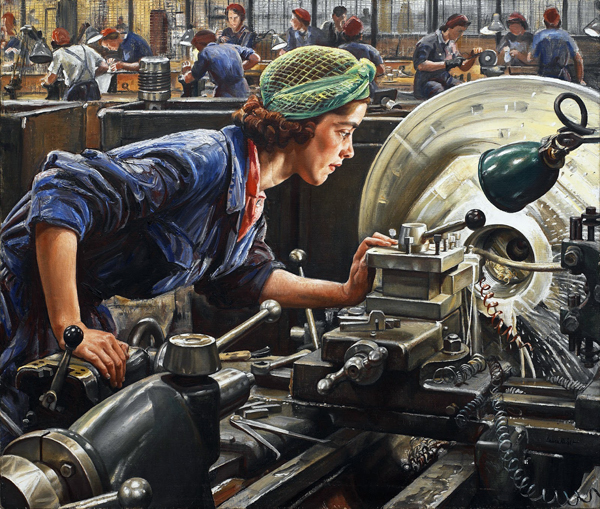
Laura Knight, Ruby Loftus Screwing a Breech Ring, 1941.
Rix, M. 1955. Industrial Archaeology. Amateur Historian 2(8): 225–229.
Roberts, P., Jr. 1880. The Puddling Process, Past and Present. Transactions of the American Institute of Mining Engineers 8: 355–362.
Rohe, R. 1994. The Chinese and Hydraulic Mining in the Far West. Mining History Journal 1: 73–91.
Roller, M. P. 2013. Rewriting Narratives of Labor Violence: A Transnational Perspective of the Lattimer Massacre. Historical Archaeology 47(2): 109–123.
Roller, M. P. 2018a. An Archaeology of Structural Violence: Life in a Twentieth-century Coal Town. Gainesville: University of Florida Press.
Roller, M. P. 2018b. Late Modernity and Community Change in Lattimer No. 2: The American Twentieth Century as Seen through the Archaeology of a Pennsylvania Anthracite Town. Historical Archaeology 52(1): 70–84.
Rosenberg, N., and L. E. Birdzell, Jr. 1986. How the West Grew Rich: The Economic Transformation of the Industrial World. New York: Basic Books.
Rosenfeld, M. 1914. “In the Factory.” In Songs of Labor and Other Poems, 7-9. Translated Rose Pastor Stokes and Helena Frank. Boston, MA: R. G. Badger.
Ross, D. E. 2013. An Archaeology of Asian Transnationalism. Gainesville: University Press of Florida.
Ross, D. E. 2017. Archaeology of the Chinese and Japanese Diasporas in North America and a Framework for Comparing the Material Lives of Transnational Migrant Communities. In Historical Archaeology through a Western Lens, edited by M. S. Warner and M. S. Purser, 138–163. Lincoln: University of Nebraska Press and the Society for Historical Archaeology.
Rotman, D. L., and J. M. Staicer. 2002. Curiosities and Conundrums: Deciphering Social Relations and the Material World at the Ben Schroeder Saddletree Factory and Residence in Madison, Indiana. Historical Archaeology 36(2): 92–110.
Rule, J. 1998. A Risky Business: Death, Injury and Religion in Cornish Mining, c. 1780–1870. In Social Approaches to an Industrial Past: The Archaeology and Anthropology of Mining, edited by A. B. Knapp, V. C. Pigott, and E. Herbert, 155–173. New York: Routledge.
Ruminski, C. J. 2017. Iron Valley: The Transformation of the Iron Industry in Ohio’s Mahoning Valley, 1802-1913. Columbus: Ohio State University Press.
Russ, K. C., R. Hunter, O. Mueller-Heubach, and M. Goodman. 2013. The Remarkable 19th-Century Stoneware of Virginia’s Lower James River Valley. Ceramics in America 2013: 200–238.
Rutsch, E. S. 1975. Salvage Archaeology in Paterson, NJ, 1973-1975. Northeast Historical Archaeology 4(1): 1–16.
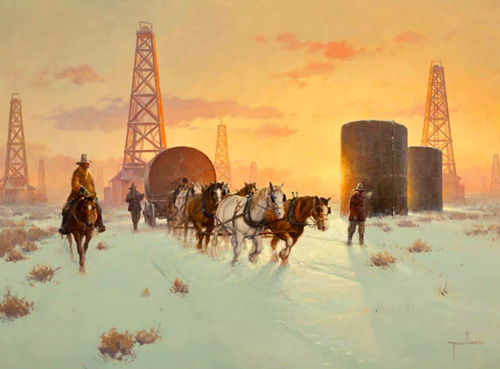
Robert Pummill, Teamwork, 1982.
Sagstetter, B., and B. Sagstetter. 1998. The Mining Camps Speak: A New Way to Explore the Ghost Towns of the American West. Georgetown, CO: BenchMark Publishing.
St. Clair, H. W. 1977. Mineral Industry in Early America. Washington, DC: Bureau of Mines, United States Department of the Interior.
Saitta, D. J. 2007. The Archaeology of Collective Action. Gainesville: University Press of Florida.
Saleeby, B. M. 2011. Living the Solitary Life: Place Mining Camps in Alaska, 1900-1950. In Eldorado! The Archaeology of Gold Mining in the Far North, edited by C. H. Spude, R. O. Mills, K. Gurcke, and R. Sprague, 259-273. Lincoln: University of Nebraska Press and Society for Historical Archaeology.
Santino, J. 1991. Miles of Smiles, Years of Struggles: Stories of Black Pullman Porters. Chicago: University of Chicago Press.
Satia, P. 2018. Empire of Guns: The Violent Making of the Industrial Revolution. New York: Penguin Press.
Scarlett, T. J., J. Rahn, and D. Scott. 2006. Bricks and an Evolving Industrial Landscape: The West Point Foundry and New York’s Hudson River Valley. Northeast Historical Archaeology 35(1): 29–46.
Scarlett, T. J., and S. R. Sweitz. 2012. Constructing New Knowledge in Industrial Archaeology. In Global Perspectives on Archaeological Field Schools: Constructions of Knowledge and Experience, edited by H. Mytum, 119–143. New York: Springer.
Scarlett, T. J., and S. A. Walton. 2017. Archaeological Overview and Assessment, Pullman National Historical Monument, Town of Pullman, Chicago, Illinois. Technical Report 142. Lincoln, NE: Midwest Archaeological Center, National Park Service.
Schallenberg, R. H. 1975. Evolution, Adaptation and Survival: The Very Slow Death of the American Charcoal Iron Industry. Annals of Science 32(4): 341–358.
Schivelbusch, W. 1986. Railway Journey: The Industrialization of Time and Space in the 19th Century. Berkeley: University of California Press.
Schmidt, P., and D. H. Avery. 1978. Complex Iron Smelting and Prehistoric Culture in Tanzania. Science 201(4361): 1085–1089.
Schmult, B. 2016. Evolution of the Hopewell Furnace Blast Machinery. IA: Journal of the Society for Industrial Archaeology 42(2): 5–22.
Schortman, E. M., and P. A. Urban. 2004. Modeling the Roles of Craft Production in Ancient Political Economies. Journal of Archaeological Research 12(2): 185–226.
Scranton, P. 1997. Endless Novelty: Specialty Production and American Industrialization, 1865-1925. Princeton, NJ: Princeton University Press.
Seely, B. E. 1981. Blast Furnace Technology in the Mid-nineteenth Century: A Case Study of the Adirondack Iron and Steel Company. IA: Journal of the Society for Industrial Archaeology 7(1): 27–54.
Shackel, P. A. 1996. Culture Change and the New Technology: An Archaeology of the Early American Industrial Era. New York: Plenum Press.
Shackel, P. A. 2000. Craft to Wage Labor: Agency and Resistance in American Historical Archaeology. In Agency Theory in Archaeology, edited by J. Robb and M. Dobres, 232–246. London: Routledge Press.
Shackel, P. A. 2004. Labor’s Heritage: Remembering the American Industrial Landscape. Historical Archaeology 38(4): 44–58.
Shackel, P. A. 2009. The Archaeology of American Labor and Working-class Life. Gainesville: University Press of Florida.
Shackel, P. A. 2010. New Philadelphia: An Archaeology of Race in the Heartland. Berkeley: University of California Press.
Shackel, P. A. 2018. Transgenerational Impact of Structural Violence: Epigenetics and the Legacy of Anthracite Coal. International Journal of Historical Archaeology 22(4): 865–882.
Shackel, P. A. 2020. An Archaeology of Unchecked Capitalism: From the American Rust Belt to the Developing World. New York: Berghahn Books.
Shackel, P. A. 2022. Introduction: The Past Made Public. In Oxford Handbook of Industrial Archaeology, edited by E. C. Casella, M. Nevell, and H. Steyne, pp. 1-12. London: Oxford University Press.
Shackel, P. A., with contributions by A. Azzarello, M. Bailey, C. Bauchat, C. Christman, K. Eppler, C. Fennell, M. Hargrave, E. Helton, A. Hsieh, J. Jacoby, C. King, H. Livingston, T. Martin, M. Nieves Colon, E. Pajuelo, M. Schroeder, E. Smith, A. Torvinen, A., and C. Valvano. 2006. New Philadelphia Archaeology: Race, Community, and the Illinois Frontier. Report on the 2004-2006 Excavations Sponsored by the National Science Foundation Research Experiences for Undergraduates (Grant #0353550). http://heritage.umd.edu/chrsweb/New%20Philadelphia/2006report/2006menu.htm.
Shackel, P. A., and M. Palus. 2010. Industry, Entrepreneurship, and Patronage: Lewis Wernwag and the Development of Virginius Island. Historical Archaeology 44(2): 97–112.
Shackel, P. A., and V. C. Westmont. 2016. When the Mine Closed: Heritage Building in Northeastern Pennsylvania. Bulletin of the General Anthropology Division 23(1): 1, 7–10.
Shackel, P. A., and S. E. Winter (eds.) 1994. “An Archaeology of Harpers Ferry’s Commercial and Residential District.” Special issue, Historical Archaeology 28(4): 1–122.
Shakespeare, M. 2017. Empire of Glass: An Unusual Industrial History Emerges from Some of the City’s Hippest Neighborhoods. Archaeology Magazine, Feb. 23. https://www.archaeology.org/issues/253-1703/letter-from/5303-empire-of-glass.
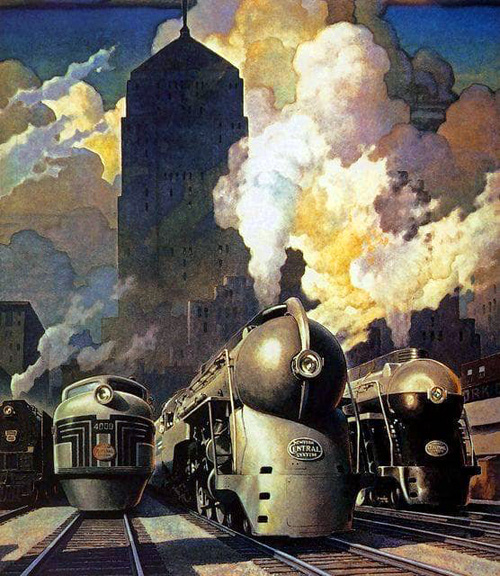
New York Central Locomotives, 1946.
Silliman, S. W. 2006. Struggling with Labor, Working with Identities. In Historical Archaeology, edited by M. Hall and S. W. Silliman, 147–166. Malden, MA: Blackwell.
Singleton, T. A., and M. D. Bograd. 1995. The Archaeology of the African Diaspora in the Americas. Guides to the Archaeological Literature of the Immigrant Experience in America, No. 2. Tucson, AZ: Society for Historical Archaeology.
Sinopoli, C. M. 2003. The Political Economy of Craft Production: Crafting Empire in South India, c. 1350-1650. Cambridge, UK: Cambridge University Press.
Sloan, E. 1904. A Preliminary Report on the Clays of South Carolina. Columbia, SC: State Co., State Printers.
Smith, B. D., and M. A. Zeder. 2013. The Onset of the Anthropocene. Anthropocene 4: 8–13.
Smith, H. L., R. O. Mills, and C. H. Spude. 2011. Alder Smoke and Shoe Nails: Life in an Early-20th-Century Mining Camp. In Eldorado! The Archaeology of Gold Mining in the Far North, edited by C. H. Spude, R. O. Mills, K. Gurcke, and R. Sprague, 239-254. Lincoln: University of Nebraska Press and Society for Historical Archaeology.
Smith, M. R. 1985. Army Ordinance and the “American System” of Manufacturing, 1815-1861. In Military Enterprise and Technological Change: Perspectives on the American Experience, edited by M. R. Smith, 39–46. Cambridge, MA: MIT Press.
Sontag, S. 1977. On Photography. New York: Farrar, Straus, and Giroux.
South Carolina Hall of Fame. 2016. Welcome Statement. http://www.theofficialschalloffame.com.
Souza, M. A. T., and L. C. P. Symanski. 2009. Slave Communities and Pottery Variability in Western Brazil: The Plantations of Chapada dos Guimarães. International Journal of Historical Archaeology 13(4): 513–548.
Spude, C. H., R. O. Mills, K. Gurcke, and R. Sprague (eds.). 2011. Eldorado! The Archaeology of Gold Mining in the Far North Lincoln: University of Nebraska Press and Society for Historical Archaeology.
Stapleton, D. H. 1987. The Transfer of Early Industrial Technologies to America. Philadelphia, PA: American Philosophical Society.
Starbuck, D. R. 1983. The New England Glassworks in Temple, New Hampshire. IA: Journal of the Society for Industrial Archaeology 9(1): 45–64.
Starbuck, D. R. 1986. The New England Glassworks: New Hampshire’s Boldest Experiment in Early Glassmaking. New Hampshire Archaeologist, special issue, 27(1): 1–147.
Starobin, R. S. 1970. Industrial Slavery in the Old South. New York: Oxford University Press.
Staudenmaier, J. M. 2002. Rationality, Agency, Contingency: Recent Trends in the History of Technology. Reviews in American History 30(1): 168-181.
Steen, C. 1994. An Archaeological Survey of the Pottery Production Sites in the Old Edgefield District of South Carolina. Report submitted to the South Carolina Department of Archives and History. Columbia, South Carolina: Diachronic Research Foundation.
Steen, C. 1999. Pottery, Intercolonial Trade, and Revolution: Domestic Earthenwares and the Development of an American Social Identity. Historical Archaeology 33(3): 62–72.
Steen, C. 2011a. Alkaline Glazed Stoneware Origins. South Carolina Antiquities 43: 21–32.
Steen, C. 2011b. Summertime in the Old Edgefield District. South Carolina Antiquities 43: 74–75.
Steen, C. 2016a. Archaeology at the Reverend John Landrum Pottery Site, 38AK497, 1987-2014: A Preliminary Report. Columbia, SC: Diachronic Research Foundation.
Steen, C. 2016b. Archaeology at the B. F. Landrum Stoneware Kiln Site, 38AK496. Columbia, SC: Diachronic Research Foundation.
Steen, C., and C. Toussaint. 2017. Who Were the Potters in the Old Edgefield District? Journal of African Diaspora Archaeology and Heritage 6(2): 78–109.
Stella, J. 1925. Pittsburgh Notes, 1921-1925. In Joseph Stella, edited by B. Haskell. New York: Whitney Museum of American Art (1994).
Stern, M. B. 1994. We the Women: Career Firsts of Nineteenth-century America. Lincoln: University of Nebraska Press.
Stine, L. F., M. Zierden, L. M. Drucker, and C. Judge (eds.) 1997. Carolina’s Historical Landscapes: Archaeological Perspectives. Knoxville: University of Tennessee Press.
Storm, A. 2014. Post-industrial Landscape Scars. New York: Palgrave Macmillan.
Stratton, M., and B. Trinder. 2000. Twentieth Century Industrial Archaeology. New York: Taylor and Francis Group.
Sunseri, C. K. 2015. Alliance Strategies in the Racialized Railroad Economies of the American West. Historical Archaeology 49(1): 85–99.
Suter, S. 2020. A Potter’s Progress: Emanuel Suter and the Business of Craft. Knoxville: University of Tennessee Press.
Swank, J. M. 1884. History of the Manufacture of Iron in All Ages, and Particularly in the United States for Three Hundred Years, from 1585 to 1885. Philadelphia, PA: J. M. Swank.
Sweezy, N. 1984. Raised in Clay: The Southern Pottery Tradition. Washington, DC: Smithsonian Institution Press.
Swope, K. K., and C. J. Gregory. 2017. Mining in the Southern California Deserts: A Historic Context and Research Design. Technical Report 17-42. Redlands, CA: Statistical Research.
Symanski, L. C. P. 2012. The Place of Strategy and the Spaces of Tactics: Structures, Artifacts and Power Relations on Sugar Plantations of West Brazil. Historical Archaeology 46(3): 124–148.
Symonds, J., and E. C. Casella. 2006. Historical Archaeology and Industrialization. In The Cambridge Companion to Historical Archaeology, edited by D. Hicks and M. C. Beaudry, 143–167. Cambridge, UK: Cambridge University Press.
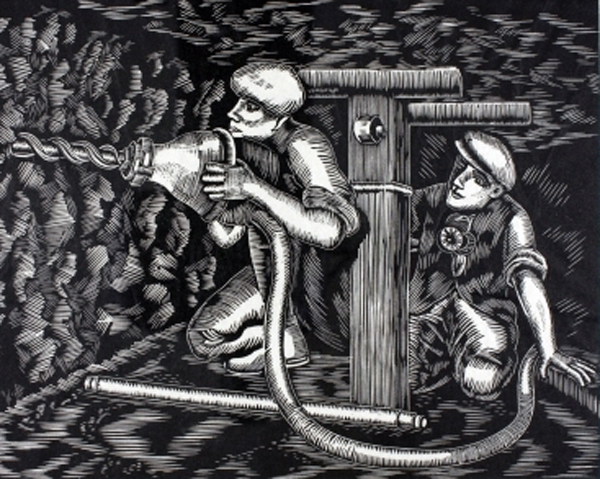
Viva Talbot, Miners Drilling, woodcut, 1930s.
Taylor, E. 1939. The Poetical works of Edward Taylor, edited by T. Johnson. New York: Rockland Editions.
Taylor, F. 2003. Scientific Management: Early Sociology of Management and Organizations. London: Routledge.
Thiesen, W. H. 2006. Industrializing American Shipbuilding: The Transformation of Ship Design and Construction, 1820-1920. Gainesville: University Press of Florida.
Thomas, J. 1971. The Rise of the Staffordshire Potteries. Bath, UK: Adams and Dart.
Thompson, E. P. 1966. The Making of the English Working Class. New York: Vintage.
Thompson, E. P. 1967. Time, Work-discipline, and Industrial Capitalism. Past and Present 38: 56–97.
Thompson, R. F. 1969. African Influence on the Art of the United States. In Black Studies in the University: A Symposium, edited by A. L. Robinson, C. C. Foster, and D. H. Ogilvie, 112–170. New Haven, CT: Yale University Press.
Thompson, R. F. 1983. Flash of the Spirit: African and Afro-American Art and Philosophy. New York: Random House.
Thornton, J. K. 1991. African Dimensions of the Stono Rebellion. American Historical Review 96(4): 1101–1113.
Todd, L. 2008. Carolina Clay: The Life and Legend of the Slave Potter Dave. New York: W. W. Norton.
Tomaso, M. S., R. F. Veit, C. A. DeRooy, and S. L. Walling. 2006. Social Status and Landscape in a Nineteenth-century Planned Industrial Alternative Community: Archaeology and Geography of Feltville, New Jersey. Historical Archaeology 40(1): 20–36.
Trinder, B. S. 1982. The Making of the Industrial Landscape. London: J. M. Dent and Sons.
Trinder, B. S. 2012. Industrial Archaeology: A Discipline? In Industrial Heritage Re-tooled: The TICCIH Guide to Industrial Heritage Conservation, edited by J. Douet, 24–30. Lancaster, UK: The International Committee for the Conservation of the Industrial Heritage.
Trinder, B. S. (ed.) 1992. The Blackwell Encyclopedia of Industrial Archaeology. Oxford, UK: Blackwell.
Turnbaugh, S. P. 1985. Introduction. In Domestic Pottery of the Northeastern United States, edited by S. P. Turnbaugh, 1–28. New York: Academic Press.
Underhill, A. P. 2002. Craft Production and Social Change in Northern China. New York: Kluwer Academic and Plenum Publishers.
United Nations Educational, Scientific, and Cultural Organization (UNESCO) 2016. Creative Cities Network: Jingdezhen. http://en.unesco.org/creative-cities/jingdezhen.
Upton, D. 1988. White and Black Landscapes in Eighteenth-Century Virginia. In Material Life in America, 1600–1800, edited by R. B. St. George, 357–369. Boston: Northeastern University Press.
United States Department of Agriculture (USDA). 1978. Soil Survey of Edgefield, South Carolina. United States Department of Agriculture, Soil Conservation Service and Forest Service, in cooperation with South Carolina Agricultural Experiment Station and South Carolina Land Resources Conservation Commission. Published by the National Cooperative Soil Survey.
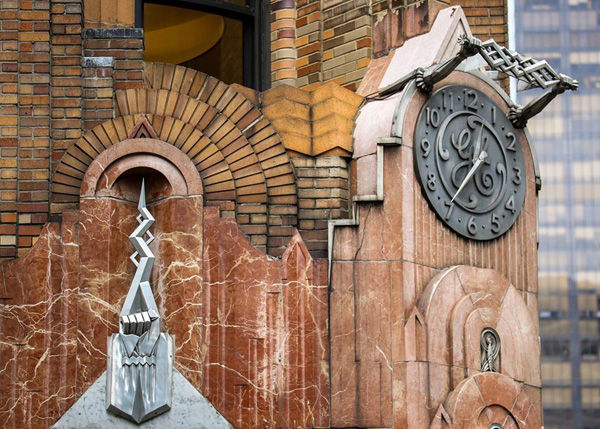
John Cross, architect, grasping electricity ornament,
General Electric Building, New York City, 1931.
Vlach, J. M. 1990a. The Afro-American Tradition in Decorative Arts. Athens: University of Georgia Press.
Vlach, J. M. 1990b. International Encounters at the Crossroads of Clay: European, Asian, and African Influences on Edgefield Pottery. In Crossroads of Clay: The Southern Alkaline-glazed Stoneware Tradition, edited by C. W. Horne, 17–39. Columbia: McKissick Museum, University of South Carolina.
Vlach, J. M. 1992. By The Work of Their Hand: Studies in Afro-American Folklife. Charlottesville: University of Virginia Press.
Vlach, J. M. 1992. Charleston Blacksmith: The Work of Philip Simmons. Columbia: University of South Carolina Press.
Vlach, J. M. 1993. Back of the Big House: The Architecture of Plantation Slavery. Chapel Hill: University of North Carolina Press.
Vogel, J. O. (ed.) 2000. Ancient African Metallurgy: The Socio-cultural Context. Walnut Creek, CA: AltaMira Press.
Vollmers, G. 2003. Industrial Slavery in the United States: The North Carolina Turpentine Industry, 1849-61. Accounting, Business and Financial History 13(3): 369–392.
Volner, I. 2011. Artsquest Center at SteelStacks. Architect 100(9): 222–230.
Vose, G. L. 1857. Handbook of Railroad Construction; for the Use of American Engineers. Boston, MA: James Munroe and Co.
Voss, B. L. 2015. The Historical Experience of Labor: Archaeological Contributions to Interdisciplinary Research on Chinese Railroad Workers. Historical Archaeology 49(1): 4–23.
Voss, B. L. 2018. The Archaeology of Precarious Lives: Chinese Railroad Workers in Nineteenth-century North America. Current Anthropology 59(3): 287–313.
Voss, B L. 2019. Archaeological Contributions to Research on Chinese Railroad Workers in North America. In The Chinese and the Iron Road: Building the Transcontinental Railroad, edited by G. H. Chang and S. F. Fishkin, 103–125. Stanford, CA: Stanford University Press.
Voss, B. L., and R. Allen. 2008. Overseas Chinese Archaeology: Historical Foundations, Current Reflections, and New Directions. Historical Archaeology 42(3): 5–28.
Voss, B. L., J. R. Kennedy, J. Tan, and L. W. Ng. 2018. The Archaeology of Home: Qiaoxiang and Nonstate Actors in the Archaeology of the Chinese Diaspora. American Antiquity 83(3): 407–426.
Voss, B. L., A. W. Kwock, C. Y. Yu, L. Gong-Guy, A. Bray, M. S. Kane, and R. Allen. 2013. Market Street Chinatown Archaeology Project: Ten Years of Community-based, Collaborative Research on San Jose’s Historic Chinese Community. Chinese America: History and Perspectives 2013: 63–74.

Racing Engines.
Walker, J., M. Nevell, and E. Casella. 2003. Introduction: Models, Methodology and Industrial Archaeology. In “From Farmer to Factory Owner: Models, Methodology and Industrialization,” special issue edited by M. Nevell. Archaeology North West 6(16): 11–16.
Walker, M. 2003. The Ludlow Massacre: Class, Warfare, and Historical Memory in Southern Colorado. Historical Archaeology 37(3): 66–80.
Walker, M., and D. J. Saitta. 2002. Teaching the Craft of Archaeology: Theory, Practice, and the Field School. International Journal of Historical Archaeology 6(3): 199–207.
Wallace, A. F. C. 1982. The Social Context of Innovation: Bureaucrats, Families, and Heroes in the Early Industrial Revolution, as Foreseen in Bacon’s “New Atlantis.” Princeton, NJ: Princeton University Press.
Walter, R. C., and D. J. Merritts. 2008. Natural Streams and the Legacy of Water-powered Mills. Science 319: 299–304, January 18.
Watts, J. 2019. Concrete: The Most Destructive Material on Earth. The Guardian, Feb. 25. https://www.theguardian.com.
Webb, W. L. 1917. Railroad Construction: Theory and Practice. New York: John Wiley and Sons.
Weitzman, D. 1980. Traces of the Past: A Field Guide to Industrial Archaeology. New York: Charles Scribner’s Sons.
Wells, T. H. 1967. The Slave Ship Wanderer. Athens: University of Georgia Press.
Whipp, R. 1990. Patterns of Labour: Work and Social Change in the Pottery Industry. London: Routledge.
White, J. R. 1978. Archaeological and Chemical Evidence for the Earliest American Use of Raw Coal as a Fuel in Ironmaking. Journal of Archaeological Science 5: 391–393.
White, J. R. 1980. Historic Blast Furnace Slags: Archaeological and Metallurgical Analysis. Journal of the Historical Metallurgy Society 14: 55–64.
White, P. J. 2016. The Archaeology of Underground Mining Landscapes. Historical Archaeology 50(1): 154–168.
White, P. J. 2017. The Archaeology of American Mining. Gainesville: University Press of Florida.
Whitehead, N. 1998. Ecological History and Historical Ecology: Diachronic Modeling vs. Historical Explanation. In Advances in Historical Ecology, edited by W. Balée, 43–66. New York: Columbia University Press.
Whitman, W. 1871. Song of the Broad-axe. In Leaves of Grass, W. Whitman, 165–176. New York: Smith and McDougal.
Wilde, O. 1891. The Truth of Masks. In Intentions, O. Wilde. London: Metheuen and Co. (1913).
Wilkinson-Weber, C., and A. O. DeNicola (eds.) 2016. Critical Craft: Technology, Globalization and Capitalism. London: Bloomsbury.
Williams, B. 2004. Opium Pipe Tops at the Market Street Chinese Community in San Jose. Proceedings of the Society for California Archaeology 17: 219–227.
Willies, L. 2004. The Mining Landscape of Cosgarne Common, Gwennap, Cornwall. In The Archaeology of Industrialization, edited by D. Barker and D. Cranstone, 95–102. Leeds, UK: Maney Publishing.
Wingard, P. 2013. From Baltimore to the South Carolina Backcountry: Thomas Chandler’s Influence on 19th-Century Stoneware. Ceramics in America 2013: 38–76.
Wolf, E. R. 1982. Europe and the People without History. Berkeley: University of California Press.
Wood, M. C. 2002a. Moving towards Transformative Democratic Action through Archaeology. International Journal of Historical Archaeology 6(3): 187–198.
Wood, M. C. 2002b. Fighting for Our Homes: An Archaeology of Women’s Domestic Labor and Social Change in a Working Class Mining Community, 1900-1930. Ph.D. Dissertation, Department of Anthropology, Syracuse Unversity, Syracuse, NY.
Wood, M. C. 2004. Working-class Households as Sites of Social Change. In Household Chores and Household Choices: Theorizing the Domestic Sphere in Historical Archaeology, edited by K. S. Barile and J. C. Brandon, 210–232. Tuscaloosa: University of Alabama Press.
Wordsworth, W. 1814. The Excursion. In The Poetical Works of William Wordsworth, vol. 5, edited by W. Knight, 332. New York: Macmillan and Co. (1896).
Wright, H. 1983. Insurance Mapping and Industrial Archaeology. IA: Journal of the Society for Industrial Archaeology 9(1): 1–17.
Wurst, L. 1993. Living Their Own History: Class, Agriculture and Industry in a 19th Century Rural Community. Ph.D. Dissertation, Binghamton University, Binghamton, New York.
Wurst, L. 2015. The Historical Archaeology of Capitalist Dispossession. Capital and Class 39(1): 33–49.
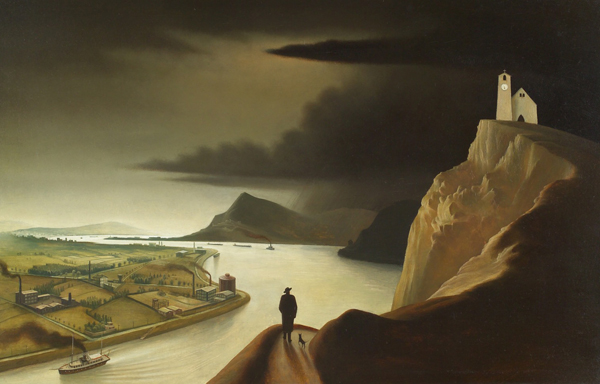
Franz Sedlacek, Industrial Landscape, 1934.
Zimmerer, K. S. 1994. Human Geography and the “New Ecology”: The Prospect and Promise of Integration. Annals of the Association of American Geographers 84(1): 108–125.
Zipper, C. E., and J. Skousen (eds.) 2021. Appalachia’s Coal-Mined Landscapes: Resources and Communities in a New Energy Era. New York: Springer.
Zraick, K. 2019. Chinese Railroad Workers were Almost Written Out of History: Now They’re Getting Their Due. New York Times, May 14. https://www.nytimes.com.
Zug, C. G., III. 1990. Turners and Burners: The Folk Potters of North Carolina. Chapel Hill: University of North Carolina Press.
Internet Resources on Industrial Archaeology
AARoads, Highway and Roads Histories:
https://www.aaroads.com/
Abandoned America, Industrial Sites (M. Christopher Photography):
https://www.abandonedamerica.us/abandoned-business-and-industry
Acting In Turn: History of Gears, Documentary (20 mins.):
https://www.youtube.com/watch?v=wEsJETJba3k
Archaeology of Edgefield, SC Pottery Communities (U. Illinois):
http://www.histarch.illinois.edu/Edgefield/
Archaeo-Metallurgical Bibliography (Oxford U.):
http://users.ox.ac.uk/~salter/arch-metals/bib01.htm
Association for Industrial Archaeology:
https://industrial-archaeology.org/
Black Craftspeople Digital Archive:
https://blackcraftspeople.org/
Bridge Truss Types (HAER):
https://www.nps.gov/hdp/samples/HAER/truss%20poster.pdf
Canals History Resources
Construction History Society of America:
https://www.constructionhistorysociety.org/
Cornish Engines, 1948 Documentary (34 mins):
https://www.youtube.com/watch?v=9rd0b0Whprs
Cornish Pumping Museum, Menominee, Michigan:
https://menomineemuseum.com/cornish-pump-museum
Derwent Valley Mills History (UK, World Heritage Site):
http://www.derwentvalleymills.org/
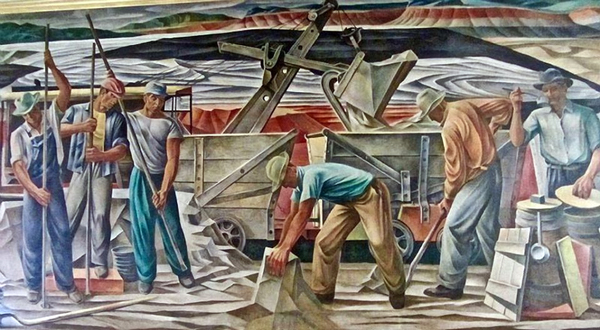
Julius Woeltz, Bauxite, mural in the Post Office, Benton, Arkansas.
Down the Old Potomac, Canal and Rail Traffic (1917 film):
https://www.loc.gov/item/00694119
Early American Industries Association:
https://www.eaia.us/
Economies Past: Early Industrialisation (U. Cambridge):
https://www.economiespast.org/
Edgefield, South Carolina Potteries Archaeology Project:
http://www.histarch.illinois.edu/Edgefield/
Elsecar, UK Works, 1880, 3D Reconstruction (Barnsley Museums):
https://www.youtube.com/watch?v=6KYqMX5EfGs
European Route of Industrial Heritage:
https://www.erih.net/
Flemish Ass’n for Industrial Archaeology:
http://www.industrieelerfgoed.be/content/english
General Archaeology Resources (U. Illinois):
http://faculty.las.illinois.edu/cfennell/bookmark2.html
Greenwich (UK) Industrial History:
https://greenwichindustrialhistory.blogspot.com/
Historic American Buildings Survey (HABS),
Historic American Engineering Record (HAER), and
Historic American Landscapes Survey (HALS) (Library of Congress):
https://www.loc.gov/pictures/collection/hh/
Historic Bridges:
https://www.yourlawyer.com/library/historic-bridges-brooklyn-bridge-and-beyond/
History of Sanitary Sewers:
http://www.sewerhistory.org/
Industrial Archaeology Image Archive (Mich. Tech. Univ.):
https://www.indarch.mtu.edu/
Industrial Archaeology Review (Taylor & Francis):
https://www.tandfonline.com/toc/yiar20/current
Industrial Archaeology Summary (M. Palmer, Oxford U. Biblios.):
https://www.oxfordbibliographies.com/
Industrial Crafts Research Network:
https://simonpenny.net/industrial-crafts.html
Industrial Heritage & Art (F. Welgemoed’s social media page):
https://www.facebook.com/groups/464056810314375/
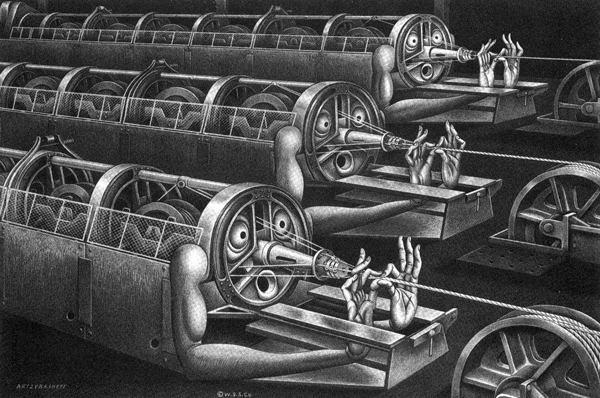
Boris Artzybasheff, Wire Mills, 1935.
Industrial Heritage Society of Ireland:
https://ihai.ie/
Industrial History New England:
https://industrialhistorynewengland.org/
Industrial Photography Archive:
http://www.hfinster.de/StahlArt2/archive-en.html
Iron and Steel History Resources
Beauty of Steel (Viktor Macha):
https://thebeautyofsteel.com/
Beckley Blast Furnace, Connecticut:
https://beckleyfurnace.org/
Catoctin Furnace, Maryland:
https://catoctinfurnace.org/
Crafting a Samurai Sword (Aeon):
Glimpse Inside a Samurai Sword Workshop
Falling Creek Ironworks, Virginia:
https://www.chesterfield.gov/
Historical Metallurgy Society:
https://historicalmetallurgy.org/
Hopewell Furnace National Historic Site, Pennsylvania:
https://www.nps.gov/hofu/index.htm
Iron Bridge Gorge and Coalbrookdale (UK):
https://www.ironbridge.org.uk/our-story/the-iron-bridge/
Industrial Archives & Library, Bethlehem, Pennsylvania:
https://www.industrialarchives.org/
Knight Foundry, Sutter Creek, California, History:
https://knightfoundry.com/sutter-creek-historic-foundry-machine-shop/
Map Directory of Iron and Steel Museums and Sites in U.S.:
https://historyhunter.org/

New York Central System Poster, 1943.
National Iron and Steel Heritage Museum:
National Museum of Industrial History, Bethlehem, Pa.:
https://www.nmih.org/virtualmuseum/
Rivers of Steel, Pennsylvania:
https://riversofsteel.com/
Rivers of Steel National Heritage Area, Pennsylvania:
https://www.nps.gov/places/rivers-of-steel-national-heritage-area.htm
Saugus Iron Works National Historic Site, Massachusetts:
https://www.nps.gov/sair/index.htm
SIA Iron & Steel Special Interest Group:
https://groups.io/g/Iron-Steel-SIG
Sloss Iron Furnace, Birmingham, Alabama, History:
https://www.slossfurnaces.com/history/
Steeworkers Archives, Pennsylvania:
https://www.steelworkersarchives.com/
Steelworks Center of the West, Colorado:
https://www.steelworks.us/
Wealden Iron Research Group, Online Publications:
https://www.wealdeniron.org.uk/publications/
Youngstown Steel Heritage, Ohio:
https://youngstownsteelheritage.wildapricot.org/
Lewis Hine’s Photography on Child Labor (U.S. Archives):
https://www.archives.gov/education/lessons/hine-photos
London Museum of Water & Steam, Engines Collections:
https://waterandsteam.org.uk/our-engines/
Mining History Resources
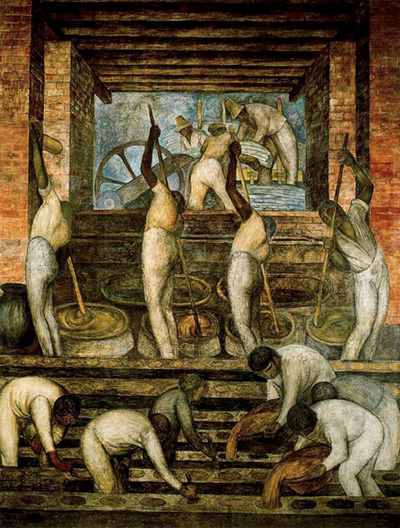
Diego Rivera, The Sugar Mill, Fresco,
Court of Labor, Ministry of Public Education, Mexico City, 1923.
Modern Ruins, Photographs by P. Buehler:
http://modern-ruins.com/
National Archives Guides to HABS/HAER:
https://www.archives.gov/research/guide-fed-records/groups/515.html
National Museum of the Great Lakes, Toledo:
https://nmgl.org/inland-seas-online/
National Park Service, Heritage Documentation (HABS/HAER/HALS):
https://www.nps.gov/hdp/
National Park Service, Industrial Heritage Parks and Sites:
https://www.nps.gov/subjects/industry/visit.htm
Newcomen Int’l Soc. for History of Engineering & Technology:
https://www.newcomen.com/
Oxford House Ind’l History Society & Risca Museum

Rene Magritte, Time Transfixed, 1938.
Railroad Histories Resources (cf. Polk 2021)
Schroeder Saddletree Factory Museum Virtual Tour (Historic Madison, IN):
https://sites.google.com/view/historicmadisoninc/hmi-properties/
Scottish industrial Heritage Society, Publications:
http://www.sihs.co.uk/publications/
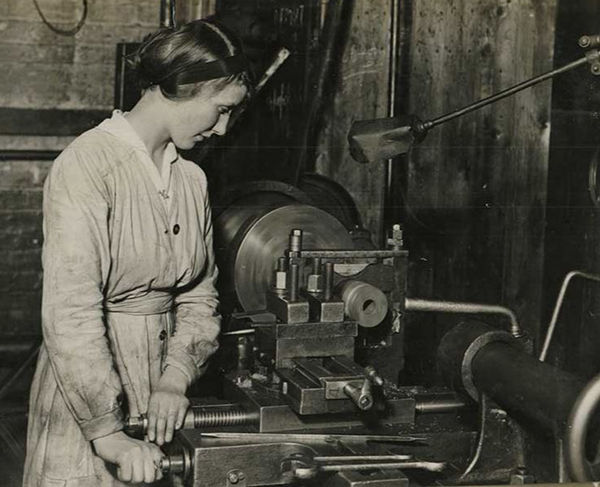
Working the Lathe, WWI, Parsons Engineering Works,
Newcastle-Upon-Tyne, C. Tyne and Wear Archive.
Society for Industrial Archaeology:
https://www.sia-web.org/
Society for the History of Technology:
https://www.historyoftechnology.org/
Stephen Mallon Photography, Machines of Interest:
https://stephenmallon.com/
The Int’l Comm. for the Conservation of the Industrial Heritage (TICCIH):
https://ticcih.org/
The Way We Worked (U.S. Archives):
https://www.archives.gov/press/press-kits/way-we-worked
Tide Mills Institute:
https://www.tidemillinstitute.org/
Two Hundred Years of Labor History (NPS):
https://www.nps.gov/blrv/learn/historyculture/200-labor-events.htm
UNESCO World Heritage List, Industrial Related Sites:
https://www.erih.net/service/links/category/
U.S. Energy History Visualization (U. Chicago):
https://us-sankey.rcc.uchicago.edu/
U.S. Geological Survey, Publications Warehouse:
https://pubs.er.usgs.gov/
U.S. Patent & Trademark Databases:
https://www.uspto.gov/
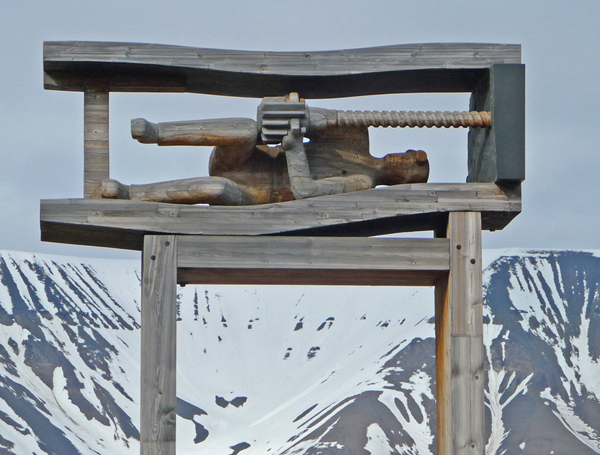
Svalbard Miners Tribute, Longyearbyen.

Last updated: Oct. 3, 2025
|
